
CONSTRUCTION
#PPETHATFITS CAMPAIGN | THE CITY’S FLOATING CRANE | HEAD INJURIES IN CONSTRUCTION constructionmanagement.co.uk JULY/AUGUST 2023
MANAGEMENT
RHYS JONES
MORE
‘LISTEN TO ALL THE VOICES’ NEW
CIOB PRESIDENT SANDI
WANTS A
COLLABORATIVE INDUSTRY
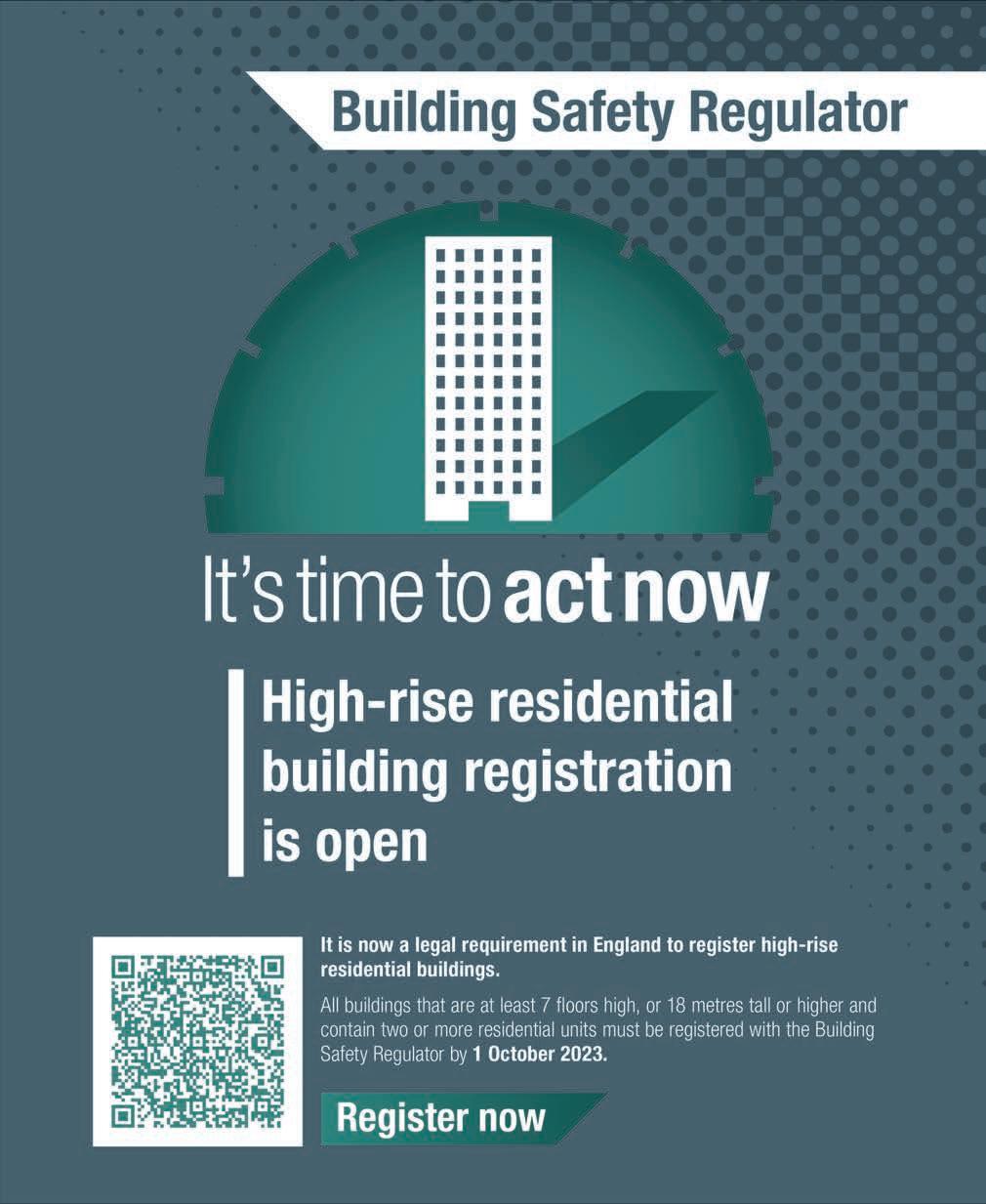

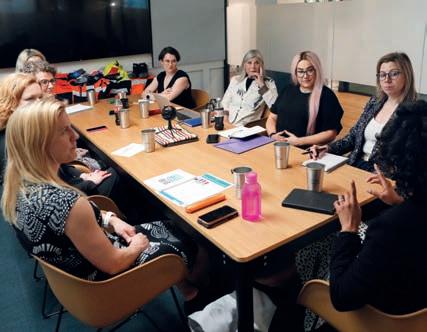


CONSTRUCTION MANAGEMENT JULY/AUGUST 2023 | 3 Contents n constructionmanagement.co.uk 07/23 Contents News 04 News in pictures 06 News: Launch of PPE campaign 07 News: CIOB’s new 21CC podcast 08 CIOB People: Football star Trevor Steven on mental health 10 Data: Further pressures on construction’s capacity Opinion 12 Caroline Gumble: CIOB Awards are back stronger than ever 13 Feedback: readers’ views Interview 18 Sandi Rhys Jones: CIOB’s new president tells CM her plans Campaign 22 Why it’s time for #PPEthatfits A new campaign for inclusive PPE Technical 26 One Leadenhall’s floating crane Robert Bird Group’s City solution Global 30 Roofing in Arctic conditions Challenges of a Greenland school Partnership 32 Hard Hat Awareness Week An expert panel talks worker safety CPD 38 Essential Principles: key points Rockwool on passive fire protection Legal 44 Contract Clinic with Andy Dunbar When archaeology causes delays Careers & Recruitment 46 ‘CIOB leads the way for industry’ Nick Cuffe on being an FCIOB Community 48 CIOB scoops EPAO award 49 New contracts for CBC Heron Bros 50 Site visits ancient and modern 51 Merseyside Hub’s new vice chair 54 Apprenticeship levy benefits 55 Primary pupils visit Henry Brothers 56 Retrofit’s hidden carbon costs Diary dates 58 What’s on over the next month Highlights of the CIOB calendar 46 26 22 10
Lighting up Birmingham
The design for HS2’s Curzon 2 bridge in Birmingham has been dubbed ‘The Bellingham Bridge’ after local footballer Jude Bellingham’s stellar performance at the 2022 World Cup. The 150m-long structure will carry HS2 trains over the Victorian brick rail viaduct below.

Celebrating women in construction
Chanelle Crawford, trainee assistant site manager at Taylor Wimpey, stands in front of her portrait at the She Builds UK photo exhibition, which aims to encourage girls and women to consider a career in the construction industry.

4 | CONSTRUCTION MANAGEMENT JULY/AUGUST 2023 n News constructionmanagement.co.uk
Expect Respect
A new campaign backed by Kier and Tarmac, Expect Respect, has been launched in Birmingham to prevent abuse and assault against road workers. In the last three years, 465 incidents of road worker abuse have been reported in the city.
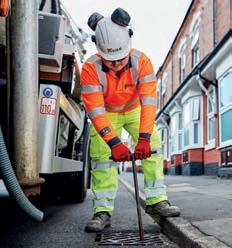
Reinforcement works
Barhale is reinforcing a section of the Thames Lee Tunnel, once believed to be the longest tunnel in Europe and a key source of fresh water for east London. The 2.6m diameter concrete-lined tunnel runs across the route of HS2 in north London.


Divine restoration
Some 130 sq m of 19th-century slates have been replaced on the roof of the chancel at the Grade II-listed parish church of Holy Trinity in Llandudno, Wales. The reroof was carried out by specialist contractor Greenough & Sons using Welsh Slate’s standardshaped Penrhyn Heather Blues.
Katherine Evans, founder of support network Bold as Brass, joined a panel of experts during the launch of the #PPEthatfits campaign, p22-25.

CONSTRUCTION MANAGEMENT JULY/AUGUST 2023 | 5 News n constructionmanagement.co.uk
PAUL GREENWOOD
CIOB launches #PPEthatfits campaign
CM and CIOB People backing campaign by new president Sandi Rhys Jones to tackle inequalities in PPE provision
CIOB has launched a major new initiative to address widespread inequalities in PPE provision across the construction industry.
The #PPEthatfits campaign will drive awareness around the lack of inclusive PPE in the market and consider how this is impacting health and safety on site, while also hampering the industry’s ability to attract and retain a more diverse workforce.
CIOB, in partnership with CM and CIOB People, will use the campaign to explore the key changes that are needed across the industry, as well as highlighting positive examples of inclusive and adaptive PPE.
Speaking at a recent roundtable event to mark the launch of the campaign, CIOB president Sandi Rhys

Jones insisted that an urgent stepchange is needed in construction’s approach to PPE, calling on contractors, manufacturers and policy-makers to take action.
“At the Chartered Institute of Building, we are determined to make a difference in this area,” she said.
“These are people’s issues,” Rhys Jones added. “It’s particularly important for women, but there are men [who are important to this change] as well. We don’t want to be exclusive, we want to be inclusive.”
The event was attended by key stakeholders from across the industry who provided detailed insight of why PPE must be sensitive to differences across the workforce – including gender, race and religion,
for example – while maintaining the highest safety standards.
Katherine Evans, geotechnical manager at Tarmac and founder of support network Bold as Brass, said: “There needs to be a change in culture. This is not about ‘a fashion show’ – people need to realise that this is about safety and that wearing the wrong size boot, for example, increases trips and falls.”
Stephanie Eynon, head of standards-makers engagement and inclusion at the British Standards Institution (BSI), added: “If you’re not given clothing that enables you to do your best job, it’s not just that you feel silly or you don’t look good. It’s about the fact that you can’t do your best work.
“It has a direct impact on your career progression and your success. Of course, safety is paramount, but there are lots of other knock-on factors that are also important. Dress for success isn’t something made up: you have to feel valued, comfortable and confident.” ● For more information about the campaign and launch, see p22.
6 | CONSTRUCTION MANAGEMENT JULY/AUGUST 2023 n News constructionmanagement.co.uk
#PPEthatfits
From left: Katherine Evans, Sandi Rhys Jones and Katie Kelleher at the launch event
It’s particularly important for women, but there are men [who are important to this change] as well. We don’t want to be exclusive, we want to be inclusive
Sandi Rhys Jones, CIOB
21st Century Construction podcast now streaming
New CIOB podcast will support institute’s modern professionalism mantra
People Projects
CIOB Awards call for new

A new podcast from the Chartered Institute of Building has launched with a mission to probe the future of construction. 21st Century Construction, or 21CC, aims to tell unusual and interesting stories to support CIOB’s top priorities: quality and safety, environmental sustainability and skills gaps.

The first episode features a Canadian architect whose team created a modular, precast concrete system for repairing Ukrainian apartment blocks damaged or destroyed by Russian missiles.
Also in the episode, construction social media influencers explain how a good LinkedIn following can boost your career prospects and attract talent to your company.
A tech jargon-busting session clears up confusion over VR, AR and MR. Also, in a feature created in partnership with Procore, the podcast explores what a ‘digital first’ construction company looks like.
Journalists from all CIOB’s publications – Construction
CIOB Awards is accepting new entries until 31 August 2023. The awards, formerly known as the Construction Manager of the Year Awards, celebrate the industry’s most influential managers and leaders.
Categories include Client of the Year and Team of the Year, plus the influential Construction Manager of
We think solutions to the industry’s issues will probably emerge from unexpected places. So, expect the unexpected and, in the process, some darn good stories
Rod Sweet, 21st Century Construction
Management, CIOB People, BIMplus, and Global Construction Review –will contribute stories to the podcast.
“Many of us on the team here have been covering construction for many years, and we think the solutions to the industry’s chronic issues will probably emerge from unexpected places,” said Rod Sweet, editor of Global Construction Review and the podcast.
“So, expect the unexpected and, in the process, some darn good stories.” ●
You can listen to the 21CC podcast for free on streaming services including Spotify, Apple and Amazon, by going to rss.com/ podcasts/21cc.
the Year. There are also categories recognising teams and individuals paving the way for sustainability and equality, diversity and inclusion. CIOB will reveal the finalists later this year. The ceremony will be at London Hilton Metropole on 9 April 2024. Entries can be submitted online at awards.ciob.org.
CONSTRUCTION MANAGEMENT JULY/AUGUST 2023 | 7 News n constructionmanagement.co.uk
New venue for the awards in 2024 In association with Listen on streaming services now Podcast 21CC 21st Century construction Brought to you by
entries
Innovation SUNDAWN
Former England star tackles mental health in construction
Former football star Trevor Steven speaks to Nadine Buddoo about how football can make a positive contribution to mental health in construction
Ex-England and Everton midfielder
Trevor Steven believes football can play an important role in helping to address the suicide rate in construction.
Steven joined construction technology provider Causeway Technologies in 2020 and is using his profile to help tackle the stigma around mental health.
“Just consider the average number of fans at every football match who also work in the construction industry – that’s a lot of people we can reach out to,” he said.
“So, what can we do to help address the suicide figures in construction? We have to encourage people to talk.”
Causeway is working closely with Everton in the Community – the
Sign up for news, interviews, expert guides, case studies and much more at: www.ciobpeople.com/newsletter
When it comes to the stigma around mental health, the environment inside a football dressing room is very similar to construction
Trevor
Steven, Causeway Technologies
football club’s official charity – to launch a major survey looking at mental health and wellbeing in construction.
The initiative aims to explore the views of construction workers on the role technology could play in helping to improve wellbeing on construction sites, while using the shared love of football to help facilitate conversations about mental health.
Steven acknowledges the traditionally laddish culture in construction – not dissimilar to football – can make it challenging for people to speak out about their mental health issues. “When it comes to the stigma around mental health, the environment inside a football dressing room is very similar to construction,” he said.
The former footballer is currently leading an outreach programme in which he visits construction sites across the country to raise awareness around mental health and wellbeing, as well as inviting workers to complete the survey.
“We hope the results will provide a snapshot of what it’s like to work in the construction industry,” Steven explained. ●
You can read the full interview with Steven at www.ciobpeople.com. Mental health support and advice for present and past CIOB members and related family is available through CIOB Assist. CIOB, in partnership with Anxiety UK, also provides wellbeing support.

8 | CONSTRUCTION MANAGEMENT JULY/AUGUST 2023 n News constructionmanagement.co.uk
Trevor Steven: “We have to encourage people to talk”
CAUSEWAY
Construction’s new people development resource
CIOB People weekly newsletter
@
A WORLD OF VALUE, ENGINEERED FOR YOU.
Knauf’s team of highly skilled and experienced Project Specification Managers are here to help deliver your project on time, and with margin to spare. With a total commitment to safety and reliable product availability, we just might be your best kept secret.

Together, let’s build for the world we live in.

Discover more at knauf.co.uk Build for the world we live in
Construction must plan for a further crunch on capacity
Skills shortages, falling outputs, rising costs and insolvencies are putting pressure on construction’s capacity, writes Pablo
 Cristi Worm
Cristi Worm
to rise, this fall is seen across almost all sectors.
Though construction output continued to increase in Q1 2023 compared with the final quarter of 2022, it was by a modest 0.7%, driven by repair and maintenance (R&M) work which rose by a significant 4.9%. Private housing R&M has seen a boom following the pandemic, while retrofit projects are also growing in response to government funding and legislation, including around energy efficiency standards.
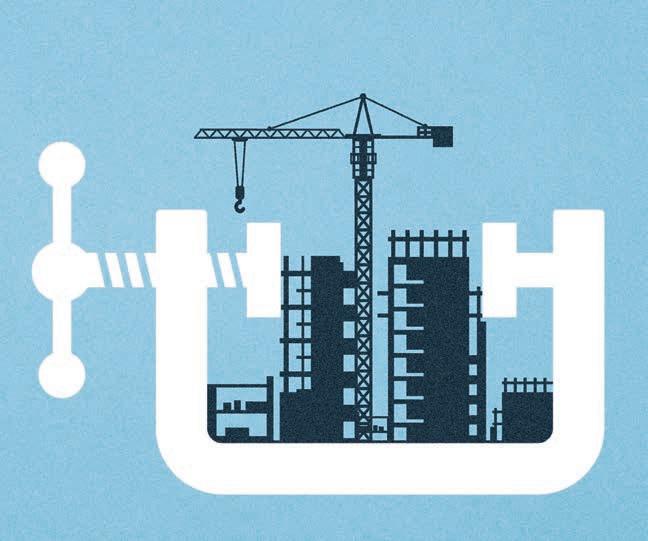
Output for new work, on the other hand, declined by 1.9% over the quarter. The overall downward trend is expected to continue this year with the Construction Products Association (CPA) recently forecasting output to decline by 6.4% in 2023, a revision down on its previous prediction of a 4.7% contraction.
Despite this cooling demand, capacity will likely remain a significant challenge for the sector, at least in the short to medium term. A shortage of skilled workers continues to put pressure on schedules and labour costs. At the same time falling output and rising costs are causing problems for contractor margins. Insolvencies in construction continue to soar – up by 9.7% in the year to Q1 2023.
The latest Bank of England forecasts suggest the UK may have avoided a technical recession. However, the construction sector is far from breathing a sigh of relief. Interest rates show few signs of easing, construction demand is cooling and high insolvencies are placing capacity under increasing pressure.
Key indicators of demand, such as sales of ready-mixed concrete, bricks, sand and gravel are trending downwards. They reflect a weakening in new orders by a substantial 12.3% in Q1 2023 compared with the previous quarter and by 14.3% compared with the same period last year. Against a backdrop of higher borrowing costs and prices for materials and labour continuing
on schedules and labour costs. At the same time falling output and rising costs are causing problems
As a result of these conditions, Turner & Townsend’s own forecasts for tender price inflation in the Q2 2023 Summer UK Market Intelligence report have increased slightly for real estate, up to 3.7% for 2023 and 2.7% for 2024.
In the face of these headwinds, some will be tempted to slow down investment in the hope of better conditions to come. However, with a subdued medium-term economic
10 | CONSTRUCTION MANAGEMENT JULY/AUGUST 2023 n Data constructionmanagement.co.uk
A shortage of skilled workers continues to put pressure
for contractor margins
Percentage fall in all new orders in Q1 2023 compared with Q4 2022

12.3
outlook, the strategy also comes with risk. One answer is to focus on programme planning and project controls – mitigating uncertainty through greater visibility.
Getting procurement right, such as considering more collaborative contracting frameworks, the proportioning of risk and building a deep understanding of supply chain capacity, will help to better plan for the challenges ahead. Putting digital strategies in place will also be important to continuously monitor and manage project performance and ensure delivery.
Construction new orders % change, Q1 2023 compared with Q4 2022
Other public new work
Private industrial new work
Infrastructure new work
All other new work
All new work
Private new housing
Total new housing
Public new housing
Private commercial new work
SOURCE: OFFICE FOR NATIONAL STATISTICS
Construction output % change forecast, revisions from the CPA
Private housing
Total housing

Public housing
Private housing RM&I
Total new work
Total all work
Commercial
Total R&M
Public other R&M
Public non-housing
Total other new work
Private other R&M
Public housing RM&I
Infrastructure R&M
Infrastructure Industrial
SOURCE: CONSTRUCTION PRODUCTS ASSOCIATION
CONSTRUCTION MANAGEMENT JULY/AUGUST 2023 | 11 Data n constructionmanagement.co.uk
-25-20 -15-10-5 05 1015 l Winter 2022/23 l Spring 2023 -20 -15 -10 -5 0 5
Pablo Cristi Worm is a senior economist at Turner & Townsend.
Caroline Gumble CIOB
The CIOB Awards are coming back stronger than ever
CIOB has been listening to members to ensure that the CIOB Awards celebrate its diverse membership, writes Caroline Gumble

Let us hear about the construction professionals who are often unsung heroes but who deserve to have the spotlight
There is fantastic work going on in the industry which deserves to be recognised and shared with a wider audience.
You may have seen elsewhere in this issue of CM the exciting news about a new venue and date for the CIOB Awards. I am already looking forward to celebrating the construction industry and the amazing people in it at our event next spring.
Many members will be aware that we have been open to conversations in recent years about how to make the most of our highly coveted awards and the annual event to present them, which has a history dating back more than four decades now.
For example, it was member feedback which led to the expansion of our awards to reflect the broad church of our membership and build on the success of the
long-established Construction Manager of the Year categories.
The addition of the rising star, sustainability, EDI, team and client categories has been well received and they now sit proudly alongside our prestigious Construction Manager of the Year award.
Conversations with members also touched on the idea to move our event to the spring, as the calendar for construction professionals in the autumn is surprisingly crowded with events and annual gatherings.
I have always maintained, though, that we must meet or even exceed the standard we have set for this event, which is one of the reasons for extending the nomination period.
The CIOB Awards will continue serving as a leading showcase for the best and the brightest among construction professionals, for those who are leading by example and setting the standards, whatever the size of a project. So please put those people forward. Let us hear about the construction professionals who are often unsung heroes but who deserve to have the spotlight.
Submitting a nomination is free and open to members and non-members – but get your nominations in before the end of August.
The CIOB Awards is a valuable platform to celebrate and cheerlead for this important industry and it has long been a highlight in our calendar. I am excited about being able to hold our event in a new London home and I’m sure it will be a night to remember. The deadline to submit a CIOB Awards nomination is 31 August 2023. ●
The CIOB Awards event will be held on 9 April 2024 in London. For more information, visit awards.ciob.org.

12 | CONSTRUCTION MANAGEMENT JULY/AUGUST 2023 n Opinion constructionmanagement.co.uk
Celebrating the industry’s finest achievements at the CIOB Awards
Feedback
A selection of readers’ comments about news and issues in the industry from across the CIOB community
CM June 2023 Back to basics
Ken Hubble MCIOB
I completely agree with Paul Constable’s comment on the quality of residential construction in the UK (Feedback, June 2023).
However, in my experience, it is not just housebuilding that suffers from extremely poor quality control. I estimate over 50% of building works in this country have very little onsite quality control.
I read many articles about moving into digital technology and how this will revolutionise the construction industry. Quite frankly, I feel we are missing simplicity.
It does not matter how much documentation and rules to follow are available if the work under construction is not being professionally supervised at the workface.
CIOB People 16/05
Valuing neurodiversity in construction

CM May 2023
Only 1 in 5 adults think construction is well paid
As an RICS member, I am fortunate to have a colleague who shares their copy of Construction Management with me. This article in particular stood out this month (News, May 2023). We are all responsible for how our industry is perceived by those on the outside and clearly we are not doing enough to change these outdated perceptions. The rise of social media use for career visibility among young people is going some way to challenge stereotypes. Despite scepticism from some more established professionals, my experience of sharing my career
online has been really positive. Campaigns such as Go Construct and The Save Construction Initiative are doing the same on a larger scale, but this counters just one part of the problem. More needs to be done to address the perceptions of older generations, who are the parents, teachers and career advisors of the young people our industry so badly needs. The solution seems simple to me: individually having more open and honest conversations with friends, family and peers about our careers and the opportunities available in the industry.
Sian Dunne MCIOB, Liverpool John Moores University
As a lecturer in construction management, one of the biggest challenges for our graduates in securing jobs in the sector is getting through ‘assessment days’.
For neurodiverse students, I fear this barrier is even harder to get through, especially if there are ‘teamwork’ type
exercises which have not considered different forms of communication.
I’m really impressed with how James Crawford has highlighted in his article about his work as a coordinator at Kier the strengths that can be brought to businesses by employing and supporting our neurodiverse community.
CM 18/05
‘Real risk’ that Parliament will be destroyed before restoration works complete Balfour Burrell MCIOB
The Palace of Westminster exceeds 900 years of history. The very thought of restoring it with all the details, pride and importance is not an easy task.
From procurement of the trades and materials to the unforeseen areas which have not been touched for centuries – it makes it an extremely difficult undertaking.
The report mentions asbestos: once this is disturbed, areas need to be closed off and further samples taken, which adds more delays. Addressing low morale, specialist skills shortage and bureaucracy are additional constraints. Some of the areas are being used while the projects are carried out. There’s also the need for planning for the unknown and the unforeseen. In a nutshell: it’s not easy. But the building is our political pride and joy and we need it to survive the test of time.
Share your views on the latest industry issues by posting comments online at www.construction management.co.uk or by emailing the editor at construction-management@atompublishing.co.uk
CONSTRUCTION MANAGEMENT JULY/AUGUST 2023 | 13 Feedback n constructionmanagement.co.uk
Sinéad Clarkson














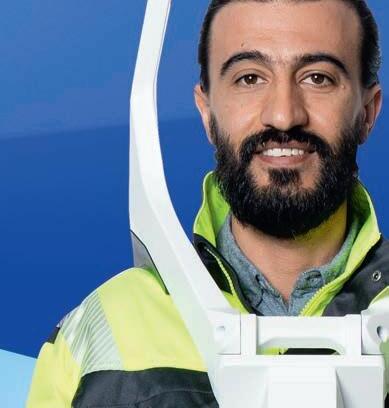



SCAN PROCESS MODEL OFFER WIN MORE DISCOVER NAVVIS VLX 3 navvis.com/lsp
Cloud computing and software have rapidly changed the world around us in fundamental ways. But not all industries can move at the same pace. Our cities, homes, schools, bridges, roads, and offices are all still built using the same core principles that date back millennia: reliable and precise measurements. Why? Because they work. When it comes to understanding the world around us, when laying the foundations of our economies, infrastructure, and systems, reliability and precision are essential.


While our principles stay the same, the world around us continues to change, to grow, and to speed up. Architecture, engineering, and construction projects are more ambitious, their scope and scale continuing to grow with every year. Public investment in infrastructure projects is rising but time frames for completion are getting shorter, all while regulatory and safety requirements are more stringent and exacting. Our principles stay the same, but our methods have to evolve to keep us fit for purpose.
New methods and tools need to integrate with and evolve existing toolkits and practices. Drawing on the established power of software and the cloud, NavVis helps Laser Scanning Professionals expand their scanning, processing, and modeling toolkit in a natural, necessary way.













The principles of reliability and precision are unchanged. NavVis helps you do more with them – quickly documenting, verifying, and collaborating on the world around us. NavVis gives Laser Scanning Professionals the right tools for the job so they can scan, process and model more data, from more sites, for more clients – in less time.

‘Listening to all the voices’
Collaboration is the theme of Sandi Rhys Jones’s term as CIOB president – and that means encouraging built environment professionals to reach out beyond the construction ‘silo’. Will Mann hears her plans
Listening is a great way to effect change,” says new CIOB president Sandi Rhys Jones OBE. “As a mediator I learned the power of asking the right question, and then being quiet, and allowing the other person time to think of their answer. As somebody who tends to talk rather a lot, it was a salutary lesson for me!
“But that is how collaboration works. It is how we gather evidence, how we learn lessons, how we find the answers. And we need to listen to as many voices as possible, because the built environment affects everybody, as illustrated by the challenges we have with building safety and net zero.”
Collaboration will be the main theme of Rhys Jones’s presidency, which starts this month. She brings to the role a rich and varied CV, which takes in experience working for contractors, clients, suppliers and government. She received an OBE in 1998 for her work promoting women in construction, a topic she is still speaking passionately about a quarter-century later.
Her presidential term coincides with the start of CIOB’s new five-year corporate plan, and she sees collaboration drawing on each of its three themes, as well as the overarching idea of ‘modern professionalism’.
She says: “I feel we have a wonderful opportunity, having identified this phrase ‘modern professionalism’, to address one of our industry’s key challenges which has concerned me for years – and that is, what do we mean by professionalism and how do we embed it throughout the industry?
“Professionalism with a capital P has traditionally implied becoming chartered, having membership of a particular group with specific competencies and commitments. But modern professionalism provides the opportunity to increase engagement and recognition with everybody in the delivery team, not simply a chartered professional. Who wants an unprofessional person delivering materials or providing site trades and crafts?
“The recent introduction of the Technical CIOB membership is a
great demonstration of the institute offering and valuing a technical level of competence, and also the importance of the apprenticeship routes. A modern professional construction manager can create the collaborative environment that improves performance – and challenge where required, too.”
One of the corporate plan themes is the skills gap, and Rhys Jones is delighted by the prospect of working with the institute’s Tomorrow’s Leaders group.
“It provides an excellent forum where we can listen to the ideas of younger people and recent entrants to the industry,” she says. “That’s particularly important for professional institutions, because, as an engineer once said to me at an international conference, ‘It’s wonderful to see everybody again, but you do begin to feel you’re in a room full of grey beards and denture suckers’.
“So how do we change that? We need to make sure the Tomorrow’s Leaders are recognised and seen. Mentoring is brilliant for that – not simply coaching to achieve specific
16 | CONSTRUCTION MANAGEMENT JULY/AUGUST 2023 n Interview constructionmanagement.co.uk
It’s down to us in the industry to demonstrate what we can do and how we do it
Sandi Rhys Jones, CIOB

CONSTRUCTION MANAGEMENT JULY/AUGUST 2023 | 17 Interview n constructionmanagement.co.uk PHOTOGRAPHY: PETER HADDOCK
Rhys Jones: “The built environment affects everybody”
objectives but broader crossdisciplinary and reverse mentoring.
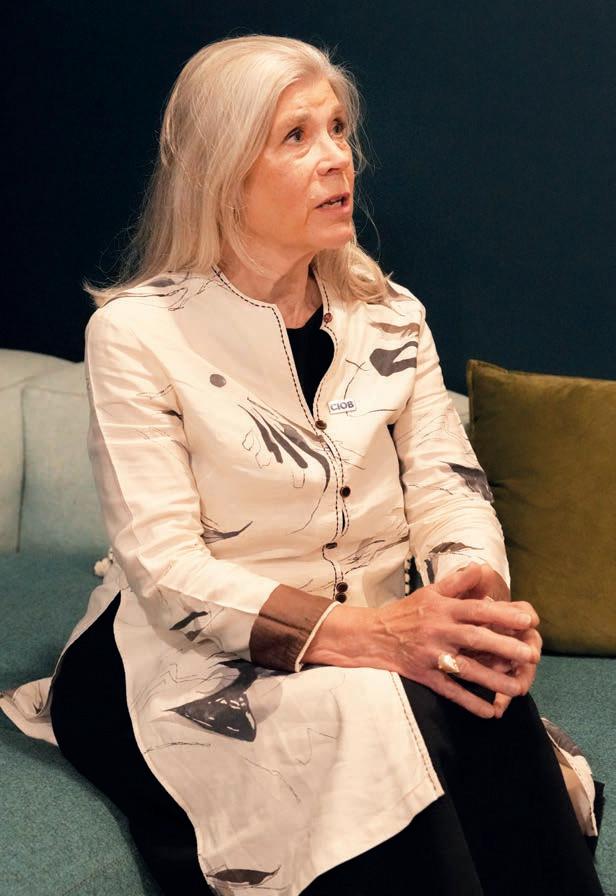
“But we must ensure that when Tomorrow’s Leaders are listened to, they feel it actually progresses their careers. We’ve lost too many built environment graduates to other industries – and we need convincing ambassadors to encourage more people to join. So again, it’s about listening to those voices we might not have done in the past and, importantly, ensuring they have the confidence, skills and opportunities to share their views and experiences with others.”
Quality and safety
Linking the skills gap with another corporate plan theme – quality and safety – is a campaign Rhys Jones is spearheading during her presidency: #PPEthatfits, which tackles construction’s inadequate provision of PPE for females in the industry (see p22-25).
“A friend got in touch to say her daughter was one of two young women doing a welding course, and neither were equipped with protective clothing until the training was almost complete,” she recalls.
“And then I started hearing similar things from other people in the industry about the difficulty of being provided with appropriate PPE.
So CIOB did a survey and 46% of respondents said the PPE they were given on site did not fit properly.
“How can it be, in 2023, that you have women wanting to work
18 | CONSTRUCTION MANAGEMENT JULY/AUGUST 2023 n Interview constructionmanagement.co.uk
in construction roles – and we can’t provide them with the right protective equipment?
“But this is also about compliance and safeguarding workers. If you are not properly equipped and you’re halfway up a ladder, or you’re working on scaffolding and you’re wearing gloves that are too big, or a hard hat that doesn’t fit properly, then it’s dangerous. And it’s a danger not only to you, but to the people who are working with you.”
Rhys Jones launches #PPEthatfits this month, supported by a diverse group of people from across the industry, and is hopeful that manufacturers, contractors and regulators will respond proactively to the campaign “before something serious happens” on a building site.
“But also, I would like to think that – for a change – this is an issue where construction can lead the way. Wouldn’t it be good if we could demonstrate to other industries like manufacturing, oil and gas – even the world of sport – that our industry is seriously addressing the issue and proposing answers to this safety problem?”
Another area of safety – building safety and quality – remains a major concern for CIOB and the construction industry and is another of the corporate plan themes.
“The two words ‘Grenfell Tower’ still rightly generate horror in me and many other people,” Rhys Jones says.
“It’s encouraging to see RIBA and CIOB working together on building safety, for example jointly publishing a guide to managing safety-critical elements in construction. We need more of that.
“It all comes back to collaboration – getting out of the silo, listening, communicating effectively and, importantly, taking a broader view
on who needs to be in the room for those discussions. Then taking action in practical and measurable ways.
“’Safety by design’ was a big focus for us when I was non-executive director of the Docklands Light Railway,” she recalls. “When the stations were built, it was not simply about providing step-free access between train and platform, it was about making sure you didn’t have to exit the station down a long dark narrow alleyway at night.”
Knowledge-sharing
CIOB recently launched a new Client Guide to help the industry’s customers on issues such as building safety and sustainability. But Rhys Jones warns that the rest of construction also needs to step up.
“One of the things that used to really annoy me was the phrase, ‘we need to educate the client’,” she says. “And so the logic went, ‘then we’ll be able to do a much better job with the built environment.’
“I think we’re moving on and recognising that, actually, it’s down to us in the industry to demonstrate what we can do and how we do it, what the assurances are and what it will cost. So, don’t let’s talk about education. Let’s talk about informing, listening and then proposing in a clear and persuasive way. Not forgetting the all-important knowledge-sharing along the way plus project reviews. The Client Guide is an excellent CIOB step in taking this forward and I am looking forward to supporting past president Mike Foy in carrying this work forward.”
Another tendency that needs addressing, Rhys Jones says, is dismissing innovative ways of working by businesses seen as ‘different’. “There is a pattern among employee-owned or

In a survey by CIOB 46% of respondents said the PPE they were given on site did not fit properly
Sandi Rhys Jones on…
SMEs
Major contractors have money, resources and time, whereas SMEs are deciding whether they can afford to even get on a framework. The CIOB can provide a valuable support role here; let’s help SMEs become more fleet of foot.”
Sustainability
“CIOB past president Michael Yam has done an excellent job raising awareness about net zero, but there are a lot of roadblocks ahead. Our housing stock is old but, with our conservation knowledge, surely we can solve this?”
Mental health
“The suicide rates in the industry are shocking, and that links into people not feeling they are respected for what they do, and not being heard.”
Government
“We have had construction ministers and housing ministers constantly going through a revolving door for many years, and we no longer have a construction advisor. I would like to see more consistency and a recognition of the value of the industry at government level.”
CONSTRUCTION MANAGEMENT JULY/AUGUST 2023 | 19 Interview n constructionmanagement.co.uk
46
privately owned businesses, who are prepared to be bolder and take a risk, compared to shareholderowned companies.
“It used to happen with Arup for example, where they would do something innovative, and people would shrug and say, ‘Well, it’s Arup’. Willmott Dixon, Laing O’Rourke and Kier are similar. The CIOB Awards highlight this work, but it is important to find and promote many more individuals and companies, of all sizes.
“The perception of innovation can also be inhibiting – a novel and effective way of working may be essentially simple, rather than rocket science.” This is where CIOB hubs can provide the examples the industry needs.
Rhys Jones also worries that UK construction companies may shy away from investing in their staff for fear of losing them to competitors.
“This may be a feature of British business culture,” she explains, “where the attitude is often ‘If I train somebody, I want to be sure I keep the benefit. If I train them and they go and work for somebody else I have lost that investment’.“
She recalls reading Francis Fukuyama’s book Trust: The Social Virtues and the Creation of Prosperity, which was published in 1996, the same year the Construction Industry Board working group she chaired produced its report on diversity in response to

● Owner, RhysJones Consultants, 1976-present
● Leader, National Mentoring Programme, Association of Women in Property, 2011-22
● Non-executive director roles: EnviroBuild, 2017-20; EngineeringUK 2008-14; Simons Group, 2002-09; Docklands Light Railway, 1998-2000
● Director, Kennington Place Management, 2001-21
● Deputy chair of trustees, Royal Marines Museum, 2002-12
● Deputy chair of trustees, UK Resource Centre for Women in SET, 2008-11
● Fellow of the Women’s Engineering Society
● Master’s degree, Construction Law and Arbitration, King’s College London, 1990-1992
● Awarded OBE in 1998 for her work in promoting women in construction
● Honorary doctorate, Sheffield Hallam University
Sir Michael Latham’s influential work Constructing the Team. “He compared the differing attitudes to training around the world, with many in Europe and Japan for example believing that if there was a culture of workforce training then everyone would benefit.
“I was also struck by his view that in an era when social capital may be as important as physical capital, only those societies with a high degree of social trust will be able to create the flexible business organisations needed. Roll on 25 years and we have all seen how Covid has dramatically changed attitudes to flexible working, for example.”
Inspiring action
But as an employer herself for many years, Rhys Jones recognises the realities of training costs, particularly for SMEs.
“We paid all fees and gave study leave, but we also had a discretionary structure under which an employee leaving within two years of completing training might be asked to reimburse a proportion. However, we as a firm generally benefited from the learning as much as the individuals themselves.
“And that’s another form of collaboration.”
Above all Rhys Jones is concerned to inspire action, to follow up on the listening and talking. Making properly fitting PPE available for women and others with particular needs, reducing the suicide rate, increasing the number and diversity of people coming into the industry, being key actors on the sustainability stage, demonstrating the competence and commitment of CIOB members and expanding the membership are all areas that Rhys Jones wants to encompass in the coming year. ●
20 | CONSTRUCTION MANAGEMENT JULY/AUGUST 2023 n Interview constructionmanagement.co.uk
Sandi Rhys Jones OBE FCIOB
The perception of innovation can be inhibiting – a novel and effective way of working may be essentially simple, rather than rocket science
Sandi Rhys Jones, CIOB

Why it’s time for #PPEthatfits
CIOB, CM and CIOB People have launched a new campaign to address the lack of inclusive PPE in construction. Nadine Buddoo and Cristina Lago brought together a panel of experts to hear their experiences of badly fitting PPE, why it is dangerous and what needs to change

22 | CONSTRUCTION MANAGEMENT JULY/AUGUST 2023 n Campaign constructionmanagement.co.uk
The current shortcomings in PPE provision are nothing new for many women working in construction. It is clear that the ‘pink it and shrink it’ strategy adopted by many suppliers is not an adequate approach to keeping the female workforce safe on site.
It is an issue that sadly struck a chord with all the attendees at a recent CIOB People round table, convened to explore the barriers –and opportunities – around providing PPE that fits everyone, regardless of shape or size.
According to Helen Gawor, director of strategy and innovation at ISG, there is a clear “lack of understanding” of the reasons why women need adequate PPE.





“It’s not just about aesthetics and comfort: it’s about safety. Unisex doesn’t suit the shapes and sizes that we are,” she said. “From my experience of working in a high-risk trade of working at height, where operatives have to wear harnesses, for example, I can’t find any analysis that looks at where those harnesses sit on a woman’s body or what the impact would be if they were involved in a fall.”
Gawor added: “It is surprising that in high-risk trades, where there are very few women and most businesses don’t have inclusive PPE available, there is an assumption that
women just require smaller sizes. Once I enquired about women’s PPE and I was sent a brochure with PPE just with smaller dimensions – which is hilarious considering that I’m 5ft 11!”
Unisex PPE
This was a sentiment shared by Sophie Perkins, senior chartered building surveyor at Atkins, who admitted she had accepted unisex PPE for years, despite it typically being tailored to fit a male body. She noted, however, that the concern around safety is just one of the issues arising from inadequate PPE.

“Although safety is paramount and I felt incredibly unsafe wearing PPE that didn’t fit me and didn’t allow me to perform my job safely, the shortcomings go beyond safety,” she said. “I nearly left the industry because I felt like I didn’t fit in. I don’t mind the colour pink, but it doesn’t help when someone patronisingly hands you pink PPE and says: ‘This is for you – there you go.’
“Your clothing is a very physical thing and it was the biggest reason why I thought I didn’t belong here. I had to act like a man with that footwear and clothing. I wasn’t succeeding at my job until I decided to do something quite radical and I started working with manufacturers to develop PPE for women, as well as other inclusivity categories.”
Perkins highlighted the need for protective clothing to accommodate an increasingly diverse workforce including, for example, different ethnicities, religions and body types. There was agreement from all attendees that the provision of more inclusive PPE would also be beneficial to men working in the industry.
Stephanie Eynon, head of standards-makers engagement and inclusion at BSI, added: “There are lots of men that would love a little bit of stretch: men don’t come in one size either. If we bring a gender lens, it will make standards better for everyone, not just women. It will enable a greater diversity of men to work safely and comfortably, as well as more women.”
Health and wellbeing
While there are examples of gender sensitive and inclusive PPE in the market, there were concerns that many construction companies use legacy suppliers that are not driving innovation through their stock. Following years of experience on major projects and with tier 1 contractors, Katie Kelleher, technical and development officer at the Construction Plant-hire Association (CPA) and former crane operator, shared her dire experience of ill-fitting PPE and the impact this can have on self-confidence.

CONSTRUCTION MANAGEMENT JULY/AUGUST 2023 | 23 Campaign n constructionmanagement.co.uk
It’s not just about aesthetics and comfort: it’s about safety. Unisex doesn’t suit the shapes and sizes that we are Helen Gawor, ISG
Sandi Rhys Jones President, CIOB Stephanie Eynon Head of standards-makers engagement and inclusion, BSI
Katie Kelleher Technical and development officer, Construction Plant-hire Association
Sophie Perkins Senior chartered building surveyor, Atkins
Katherine Evans Founder, Bold as Brass
Chairs: Nadine Buddoo, editor, CIOB People, and Cristina Lago, deputy editor, CM
Helen Gawor Director of strategy and innovation, ISG #PPEthatfits
Rachel Tomkins Head of assurance, security and facilities, Tideway London
“It all starts when you go on site and they ask you what size of PPE you need but once you slide it on, it doesn’t fit. It’s an embarrassing situation because you have a bloke in front of you and you feel judged. You end up with some oversized high-vis trousers bunched up around your shoes at the bottom and a jacket hunching around your neck and floppy arms hanging over your hands. How can I operate a crane in a jacket with sleeves that are absolutely massive?”
Kelleher explained that as well as looking “like an idiot”, there are also some serious health implications. On one occasion she was given boots that caused a condition called plantar fasciitis, commonly referred to as a policeman’s heel. “Although the size was right, the heels were a problem,” she added. “I’ve just never experienced good PPE.”
Katherine Evans, geotechnical manager at Tarmac, had similar concerns about the dearth of inclusive PPE and the effect this can have on workers’ health and wellbeing. “I don’t think it’s because
companies are not trying. Instead, I think it’s a block in lots of people’s minds that don’t understand what the problem is and who don’t get what’s the difference between a man’s gloves and a woman’s gloves, or the differences between the shapes of shoes and sizes of feet,” she said.
Culture shift
Responding to the need for change, Evans created Bold as Brass – a women’s network championing equity across the industry. While groups like this can provide useful resources and signposts to inclusive PPE, Evans believes a broader change in culture is needed across the industry.
“This is something a lot of people are struggling with because they have no leg to stand on. When it comes to fighting for what they need… women and others who need different PPE source it themselves and then expense it back,” she said.
Evans added that at the heart of the issue is the purchasing department in big companies, which is often “run by men who don’t see
a problem here”. “And even if you have a really good procurement department that has an approved supplier list with women’s PPE on it, you have managers standing in the way who can be too lazy to find out how to do something different.”
Eynon shared this concern and added that the entire process should be reviewed. “Who’s purchasing this PPE? What do they know about the needs of the people whom they are purchasing for? What do they know about the suppliers? Do they have enough knowledge about the suppliers available on the market and the range of PPE that’s on offer? All these questions keep coming up.”
From left: Katherine Evans, Sandi Rhys Jones and Katie Kelleher
From left: Helen Gawor, Stephanie Eynon and Sophie Perkins

The discussion turned to the role inclusive PPE can play in attracting and retaining a diverse workforce.
“Women feel less comfortable getting into the industry because they feel they don’t fit. And companies do not always want to employ more women because they think it will cost them more money and because they think it dangerous to have women on site because statistics might show that they are more likely to have accidents –probably due to PPE that doesn’t fit properly,” added Eynon.
“So what evidence do we need? What different story do we need to tell to really create structural and systemic change?”
Change makers
CIOB president Sandi Rhys Jones agreed that systemic change is needed in traditional approaches to purchasing PPE. However, she noted: “You can only go so far with the establishment. Change is driven by individuals who say that they can’t put up with this anymore.
“Women at this round table have demonstrated [how they have
24 | CONSTRUCTION MANAGEMENT JULY/AUGUST 2023 n Campaign constructionmanagement.co.uk
tackled this challenge by] going down, round and under – that’s how change happens.”
Rhys Jones also highlighted the importance of finding male allies. She said: “One of the people I spoke to about this PPE campaign was a man who said he got fed up with his purchasing department and at his own time and expense he would drive to alternative suppliers.”
To support a real step-change in the approach to PPE, there was consensus that policy and legislation must play a significant role.
“We have to start with legislation, whereby you have to provide gender-appropriate PPE for your workforce,” insisted Rachel Tomkins,
head of assurance, security and facilities at Tideway London. “When we are talking about quality, there isn’t necessarily a legal standpoint that you are protected by. But when you are talking about safety, you are required to be safe to do your work.”
Rhys Jones outlined CIOB’s commitment to making a difference in this area and suggested working in partnership with BSI to produce a guidance document to drive the provision of more inclusive PPE.
“These are people’s issues,” she added. “It’s particularly important for women, but there are men [who are important to this change] as well. We don’t want to be exclusive –we want to be inclusive.” ●
Show your support for #PPEthatfits
We want to hear from CM readers about your experiences with PPE – whether it’s PPE that doesn’t fit properly or innovative manufacturers which are producing inclusive PPE that is not just designed for men.
Get in touch with nadine.buddoo @atompublishing.co.uk or cristina.lago@atompublishing.co.uk. Alternatively, share your stories on social media and support the campaign, using the hashtag #PPEthatfits.
It is surprising that in high-risk trades, where there are very few women and most businesses don’t have inclusive PPE available, there is an assumption that women just require smaller sizes.

Helen Gawor, ISG
I nearly left the industry because I felt like I didn’t fit in. I don’t mind the colour pink, but it doesn’t help when someone patronisingly hands you pink PPE and says: ‘This is for you – there you go.’
Sophie Perkins, Atkins
You end up with oversized high-vis trousers bunched up around your shoes and a jacket with floppy arms hanging over your hands. How can I operate a crane in a jacket with sleeves that are massive?
Katie Kelleher, CPA
Even if you have a really good procurement department that has an approved supplier list with women’s PPE on it, you have managers standing in the way who can be too lazy to do something different.
Katherine Evans, Bold as Brass
There are lots of men that would love a little bit of stretch: men don’t come in one size either. If we bring a gender lens, it will make standards better for everyone, not just women.
Stephanie Eynon, BSI
This is about being inclusive. One of the people I spoke to about this PPE campaign was a man who got fed up with his purchasing department and at his own expense he found alternative PPE suppliers.
Sandi Rhys Jones, CIOB
We have to start with legislation, whereby you have to provide genderappropriate PPE for your workforce. When we are talking about safety, you are required to be safe to do your work.
Rachel Tomkins, Tideway London.
CONSTRUCTION MANAGEMENT JULY/AUGUST 2023 | 25 Campaign n constructionmanagement.co.uk
The City’s floating crane
Perched on the outside of the fast-rising One Leadenhall development, an unusual tower crane is speeding up construction on this new City office building.

Kristina Smith reports
From a distance, it looks as if it’s floating. A tower crane serving the One Leadenhall site in the City of London is growing out of the building’s partially erected steel frame. It’s a lovely bit of engineering. Designer Robert Bird Group’s goal was to improve construction sequences and shave time off the programme for client Brookfield Properties.
“It’s all about solving logistical problems,” says Matt Quilty, project director for Robert Bird. “Putting the crane here means you can accelerate the build because you are not having to work round it.”
Robert Bird Group is both the structural engineer and the temporary works engineer on this project. This means that, working with construction manager Multiplex, it can win multiple programme, cost and material gains by designing the permanent and temporary works in tandem.
26 | CONSTRUCTION MANAGEMENT JULY/AUGUST 2023 n Technical constructionmanagement.co.uk
The crane sits on a bespoke steel H frame cantilevered off the building’s structure
Tight City site
With the busy Gracechurch Street running down one side of the plot, this is a typical tight City site. One Leadenhall, which replaces the seven-storey Leadenhall Court, will be far higher than its predecessor at 35 storeys. However, its design by Make Architects means the height is less obvious from street level: the first four storeys have a masonry block design to reflect the feel of adjacent streets, with a glass tower stepped back and rising up from that.
The steel frame of the 40,000 sq m office building, which will have some retail units on its ground floor as well as a fourthfloor viewing platform open to the public, has a central concrete core to provide stability. A composite floor wraps around the central core with columns located only at the building’s perimeter to provide an uninterrupted floor space. The corners of the building are column-free too, to maximise views for future tenants.

The plot is next to the Grade II*-listed Leadenhall Market, which is being closely monitored throughout the construction process. Whereas the old building had a one-storey basement, the new one has a two-storey one. Robert Bird’s design saw excavation of the new basement through the existing one, using the perimeter
of the old basement floor as a waling beam to provide stability to during construction.
“We used a top-down construction sequence and reverse engineered the basement structure as it was originally designed, going back to the original drawings,” explains Quilty.
The 100 new piles for the basement, 30m long and dry bored, were designed to reach to the bottom of the London Clay and located to avoid the positions of the shorter piles which supported the previous building.
Robert Bird, which also carried out the geotechnical engineering for the project, chose dry piles because this avoided the need for a bentonite plant on site which would have used up precious floor space. Again, explains Quilty, the design sought to optimise working space for Multiplex so that all the activities could progress faster.
Where temporary and permanent combine
The tower crane on the outside of the building isn’t really floating. It sits on a bespoke steel H frame which is cantilevered off the steel frame of the building. Specialist contractor William Hare manufactured both the permanent and temporary steel and designed the fixings. The crane’s mast will tie into the building at levels 8, 17, 23 and 29.
The 100 new piles for the basement, 30m long and dry bored, were designed to reach to the bottom of the London Clay 100
“Since we are both the structural engineer and the construction engineer, we were able to integrate and enhance the permanent steel to take the additional forces in the temporary condition from the crane in the very early phases,” says Quilty.
“We’re not putting in temporary works – we are enhancing the beam by a small amount to make sure it can do two jobs: hold the floor in the permanent condition and the crane in the temporary condition. It is a much more sustainable way to build.” Adding in temporary steel support work later could have had other knock-on effects too, says Quilty. The flanges of the floor beams have large holes in their webs for building services to pass though;
CONSTRUCTION MANAGEMENT JULY/AUGUST 2023 | 27 Technical n constructionmanagement.co.uk
3D render of the crane grillage
Since we are both structural and construction engineer, we were able to integrate and enhance the permanent steel to take the additional forces from the crane
Matt Quilty, Robert Bird Group
additional beams could have interfered with that, for instance.
The trickiest thing about designing the grillage and crane system was making sure that it would not interfere with the facade, which has mullions every 1.5m. “We really had to think about where we put the ties,” says Quilty.
Robert Bird engineers also had to check all the deflections of the crane and the building and how they impacted on each other. “You have to be aware of the construction tolerances and the movements of the grillage which you are superimposing on the movements of the building,” says Quilty.
“If you are doing this type of bespoke system you need to work closely with the permanent engineer.” Which is easier when you work for the same company and are sharing the same model.
The crane, which is a Terex CTL 282-18 Luffing Jib Tower Crane, is currently 72m tall with a 25m jib. It has the capacity to go up to a 140m mast in its final phase with a working jib of 30m. It was erected with the help of one of the other two tower cranes on site, both of which are climbing cranes sitting within the building’s core.
Robert Bird, which has designed similar cranes for projects at
22 Bishopsgate and 100 Bishopsgate, was able to design the concrete core with shelves within it to support the climbing cranes.
“Every time we design a system like that, we improve it,” says Quilty.
All cranes are now hard at work, with the concrete core having reached level 24 by early June and the steel frame almost up to level 16.
One Leadenhall’s crane isn’t unique. Robert Bird designed a similar one for the Shard, back in 2009 – although that one was higher up, so not so noticeable from street level, says Quilty. However, it is a neat solution in a very tight working environment. ●

28 | CONSTRUCTION MANAGEMENT JULY/AUGUST 2023 n Technical constructionmanagement.co.uk
Every time we design a system like that, we improve it Matt Quilty, Robert Bird Group
The system was carefully designed to avoid interfering with the mullions of the facade

Roof of the world
In Nuuk, the world’s northernmost capital, the design and construction of a new school had to allow for the harsh climatic conditions and blend in visually with the mountainous backdrop. Rod Sweet reports

Developing a school in an extreme climate is a special challenge.
What works in ‘standard’ environments is not sufficient.
Although Greenland’s capital Nuuk lies some 200km south of the Arctic Circle, Copenhagen-based architectural firm KHR had to bring its arctic expertise to bear in designing the Atuarfik Nasasuaq school in the centre of this low-rise city of 17,000. Its previous commissions, similarly sensitive to the Greenland landscape, include the Greenland Institute of Natural Resources, the Malik Swimming Hall and a previous school.
Set to accommodate 1,200 pupils and 120 pre-schoolers, Atuarfik Nasasuaq school consists of six rectangular buildings staggered over a long building plot, creating a series of indoor and outdoor spaces for learning and playing that open onto the surrounding community. It replaces several old buildings that no longer met the required standard.
The school will also function as a new meeting place in the city. A large central space with an adjoining canteen can be separated from the rest of the school for events and clubs, even during school hours.
The sculptural roof forms complement the shape of the mountain range, creating an elongated ridge from most angles
Greenland’s capital Nuuk, with 17,000 inhabitants, lies under the 1,250m peak of the country’s famous mountain, Sermitsiaq
Blowing a gale
Arctic design considerations include very strong winds, so strong they can make it impossible to open a door against them. So KHR designed entrances on each of the buildings’ four sides, giving pupils the safest place to enter and leave the school whichever direction the wind is blowing.
In the long, dark winters, it’s necessary to use the available daylight as effectively as possible. The design ensures that the light enters the building without dazzling it, regardless of the position of the sun, thanks to the high slanted skylights.
30 | CONSTRUCTION MANAGEMENT JULY/AUGUST 2023 n Global constructionmanagement.co.uk
The school’s sloping roofs ensure the region’s abundant snow will not build up to damaging levels.
Loving the landscape
The main theme of the design reflects the Greenlandic story of nature as a basic requirement for life.
Since the Sermitsiaq massif is the backdrop to everything in Nuuk, KHR decided the profile of Atuarfik Nasasuaq school should pay homage to its 1,250m peak and two most prominent sub-peaks.
The sculptural roof forms complement the shape of the mountain range, creating an elongated ridge from most angles, while the school buildings with their
moderate height fit in well with surrounding buildings.
The unusual roofscape, with the polygonal tops housing skylights, was realised with standing seam elements from Kalzip produced on site. The aluminium profile panels allow for the individual geometry of the roof.
Freezing mittens
The penetration-free roof cladding has no weak points caused by fasteners, a big plus in the Arctic winter. Its lightweight design bridges large spans easily.

As an industrially pre-produced aluminium roof system, it allows short construction times, necessary in the short Arctic summer to get the roofs installed.
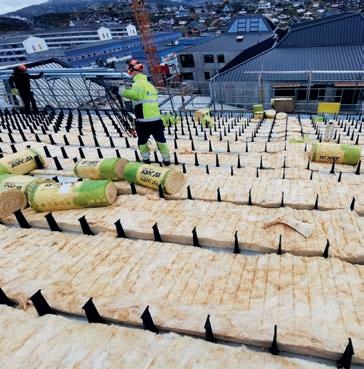
Owing to the tight schedule, installation had to continue even in the arctic winter at -25°C at times under floodlights.
“Even though our gloves sometimes freeze to the sheet metal, we are still glad that the Kalzip sheets can be laid properly in wind and weather,” said Per Mortensen,
from roofing and facade contractor AE Stalmontage. “With any other material we would not be able to keep to the tight schedule.”
Nuuk is developing, with a view to taking its place as an international city. Atuarfik Nasasuaq school is intended to be a new landmark as well as a great place for kids. ●

CONSTRUCTION MANAGEMENT JULY/AUGUST 2023 | 31 Global n constructionmanagement.co.uk
The roofs of the school had to be installed before winter
Even though our gloves sometimes freeze to the sheet metal, we are still glad that the Kalzip sheets can be laid properly in wind and weather
Per Mortensen, AE Stalmontage
KHR’s render of the school
How can construction protect workers from head injuries?
Worker safety on construction sites is paramount, so when it comes to concussion and other head injuries, can lessons be learned from contact sports like rugby and football? Does the construction industry understand enough about head injuries and protection? And is today’s hard hat technology enough to safeguard employees doing their job? Ahead of Hard Hat Awareness Week during 12-18 June, a panel of experts, chaired by CM editor Will Mann, discussed these issues
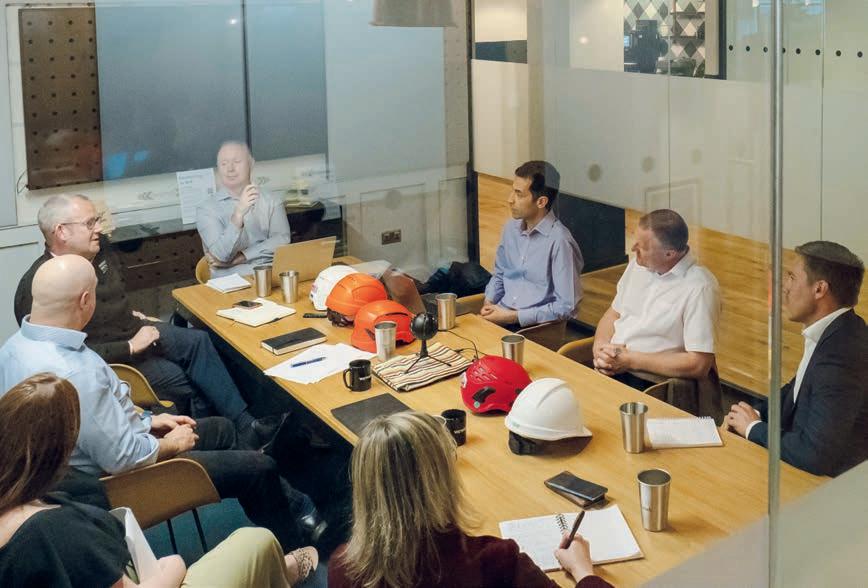
32 | CONSTRUCTION MANAGEMENT JULY/AUGUST 2023 n Partnership constructionmanagement.co.uk
PHOTOGRAPHY: JAMES JOHNSON
Will Mann: What do you think of current understanding about head injuries in construction, including the ability to diagnose concussion?

Chris Tidy: We absolutely need a better understanding of what concussion is, given the number of head injuries there are in construction. And we not only need to understand more about how to try to prevent injuries, but we need to look at how we can go about reporting them better. I’d like to see greater awareness and education around head injuries, both in terms of trying to prevent them and reporting them when they happen.
Mazdak Ghajari: Concussion is certainly an emotive word. First of all, we need to understand what concussion is. It has certainly confused everyone in the sports industry, and much research has gone into defining the biomechanical threshold for what concussion is. We need to know what it is we are discussing; we need to ensure we are measuring the right things and that we are measuring them in better ways in order to improve protection.

Olof Rylander: How do you educate a team of subcontractors, numbering in their thousands, about when they need to go and see a doctor if they receive a blow to the head?



One of the issues around concussion is that you don’t see the effects immediately. You might get hit on the head and think it’s not too bad, but the symptoms can take a few days to manifest themselves. People need to recognise when they should go to a doctor. Awareness and education are really important because in my experience the understanding of this issue is pretty low.
Russel Pieters: One of the issues is that RIDDOR – Reporting of Injuries, Diseases and Dangerous Occurrences Regulations – doesn’t provide enough space to report the detail of an injury. We need more data in there. And we need a better understanding of how and what gets reported. If I stand up and bang my head on a shelf, is that a reportable incident? It boils down to better understanding, better communication across the industry, as well as people wearing the right safety product for the situation they are in.
Chris Bentley: I don’t think there is a great deal of knowledge in the industry around the diagnosis of concussion following head injuries. Of course, our project first aiders would be able to identify the more obvious symptoms of concussion, but maybe not the more subtle ones. In most instances of a head injury the first aiders would direct the injured person to visit a medical professional, however in more subtle head injuries associated with trips and falls this may not be the case. Some improved knowledge on this through first aid courses etc would be useful.
WM: Do you feel there is enough education around head injuries and head protection in general?
MG: The sooner we can start educating people, the better. From school age, even. There are many injuries, that affect all parts of the body. But injuries to the head and brain are really important. Yes, if someone breaks a leg, their mobility will be affected for a time, but what appears to be a relatively simple head injury can ultimately change

CONSTRUCTION MANAGEMENT JULY/AUGUST 2023 | 33 Partnership n constructionmanagement.co.uk
What appears to be a relatively simple head injury can ultimately change someone’s life, their personality, forever
Dr Mazdak Ghajari, Imperial College London
In association with
Chris Tidy Hard Hat
Awareness Week founder
Christopher Bentley UK safety, health and environment manager, Morgan Sindall
Olof Rylander Senior business developer for safety, Mips
Dr Mazdak Ghajari Lead researcher at the Head Lab, Imperial College London
Russel Pieters Senior sales manager, MSA Safety
Early education around the more subtle head injuries, such as those from trips and falls and striking your head on objects, and how to protect against them, would only be a good thing
Christopher Bentley, Morgan Sindall
someone’s life, their personality, forever. It can take a long time for the effects to be evident, but sports like football and rugby now recognise the dangers. Maybe in the construction industry not so much. So educating people is crucial.
CT: It’s often a difficult topic to broach among children, those who might be put off playing rugby or cycling, if you spend a lot of time telling them about concussion. But we should be doing it somehow.
And definitely, from an industrial perspective, we need better induction procedures, and we need to spell out why people are being required to wear this kit and
explain what it’s protecting against. Currently, we just tell people to wear stuff without going into the reasons why they should.
OR: Being a health and safety officer in a company must be a challenge. Head protection is just one part of safety, and you have an enormous number of different PPE products to choose from. When it comes to head protection equipment, we need to understand to what standard it has been manufactured. There are many products to choose from and – given that contractors aren’t necessarily going to be experts in head protection, foot protection and so on – it is essential to educate people on what is most appropriate for the tasks involved.
CB: When people think of construction-related head injuries, they automatically have an image of being struck by a dropped object. In my career as a safety professional, I have only seen two significant head injuries from this type of event and some of the workforce may never have seen any, which can lead to the belief that head injuries aren’t commonplace.
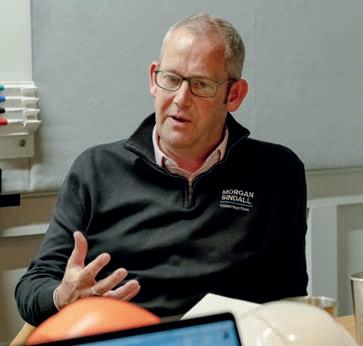
I think early education around the more subtle head injuries, such as those from trips and falls and striking your head on objects, and how to protect against them, would only be a good thing.
CT: As Hard Hat Awareness Week, we’ve offered to come and talk to construction companies about head injuries, and they’re not interested. When you compare injuries occurring from dropped objects to those from slips, trips and falls, yes, the latter causes of injuries are much higher. But mitigating the risk and informing people about it has to be good for everyone.
It’s about educating people; it’s not about trying to sell health and safety gear. I find it interesting when people take that approach because that’s not what we’re trying to do. I’ve always been very clear: it’s about education, not sales.
WM: Do you think that current safety helmets offer sufficient protection for workers, particularly for accidents involving ‘rotational motion’?
MG: That’s a very good question. From studies we’ve done, we can see that it’s rotation of the head, rather than linear motion, which produces the greatest shear to the brain.
Both we and MIPS have been doing testing around this, but more work needs to be done. In parts of the testing chain, there are elements missing. We need better data to better inform our lab tests. This can lead to better lab testing of a wider range of helmets with different features. The key is now how we design the lab test
34 | CONSTRUCTION MANAGEMENT JULY/AUGUST 2023 n Partnership constructionmanagement.co.uk
Christopher Bentley: “A worrying trend is fitting wearable technology onto hard hats”
to best approach that. And for that to succeed we need data.
CB: I’m not hugely familiar with the term ‘rotational motion’, and I’m not sure that the industry, in general, is fully aware of the risks associated with the issue. An educational element here needs to be addressed to improve the industry’s understanding of rotational motion risks and how they can be reduced through innovation within head protection design.
OR: To explain the rotation motion that we’re talking about, the brain fills up most of the skull. With linear movement, the brain won’t move
much in relation to the skull, and there’s little strain on the brain. But with rotational motion, the brain can start to rotate inside. And if that rotation is large enough, it can result in shearing of brain tissue, and that’s why those rotational motions can prove to be dangerous.
CT: As with most activities it comes down to the data. It’s also about understanding the incidents that are taking place and tailoring helmets, hard hats, to those situations. Currently, we just don’t have a 100% clear picture of the types of incidents that are taking place. Helmets are just tested for linear impacts only. We have to
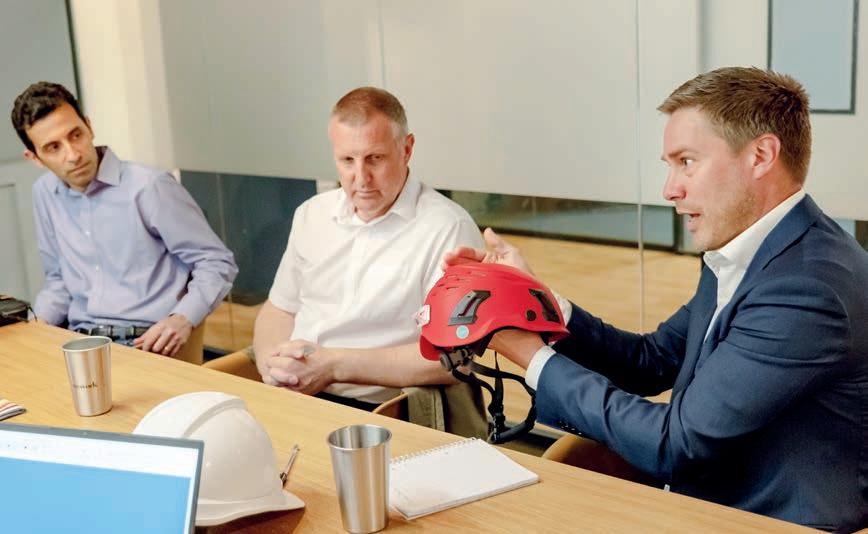
lift standards beyond the basic requirements to the point where manufacturers attain standards that meet rotational as well as linear impacts.
OR: We definitely need more data to understand what’s going on. But in the multiple tests we’ve done, we’ve seen that most of the impacts have a combination of linear and rotational forces, which happens in the real world on a construction site. And studies have shown that rotational impacts have a greater impact on the brain. Then, in my opinion, there is movement on the market with new helmets and technology coming which is nice to see.
CONSTRUCTION MANAGEMENT JULY/AUGUST 2023 | 35 Partnership n constructionmanagement.co.uk
From left: Dr Mazdak Ghajari, Chris Tidy and Olof Rylander
Educating people about the risks and how to protect against them should also extend to those non-site staff who don’t experience the scale of the risks involved

Russel Pieters, MSA Safety
RP: From our R&D perspective we’re constantly assessing different technologies that can be used for a range of impact situations, from rotational movement to top and side impacts. We look at arc flash protection and temperature stress, particularly when working in extreme hot and cold conditions.
But then you run into the issue of procurement. A company’s procurement team has a tough job because their health and safety team wants the best product, and they have to work with the budgets they have. Educating people about the risks and how to protect against them should also extend to those non-site staff who don’t experience the scale of the risks involved. ●
What is your experience of good and bad practice in mitigating head injuries in construction?
CT: Obviously a lot more people are wearing hard hats than before, but there are still cases of bad practice where people don’t wear them properly, like putting them over hoodies. Chinstraps are essential in keeping a hard hat correctly in place, but they can be uncomfortable, so people don’t always do them up, which can cause the obvious issue of hard hats falling off and problems arising if something hits their head at that point. Hard hat safety will only be good for you if the product remains on your head.
OR: We need to manufacture helmets so that they are comfortable to wear. I come from the land of Volvo, and in Sweden there are strict requirements for main
Hard Hat Awareness Week ran from 12-18 June. Go to www.hardhatawarenessweek.com for more information on head injuries and good safety practices. Show your support by posting on social media using the hashtag #HardHatAwarenessWeek or #HHAW23.

and subcontractors around wearing hard hats. And it’s not just Sweden. I was recently on a site in the US, in Kansas, where there were thousands of workers and every single one of them was wearing a hard hat with the chinstrap done up. The construction firm had a policy of: “You do up your strap, or you go home.” Sometimes it’s good to be tough on this.
RP: I’ve seen some really bad examples of hard hat wearing. Hoodies, woolly hats, wearers putting stuff in between the hard hat’s liner and the shell. Crazy stuff. Having cooling liners helps. And chinstraps need to be of the right type. The product needs to be used correctly. If you’re not using it correctly, why use it all? In the UK, you have workers from many countries, and their understanding of UK safety processes may differ. It comes down to communication and, again, education.
CB: I’ve seen people drill holes in their hard hat for ventilation, stuff oily gloves inside them, which have resulted in skin irritations, or cover them with induction stickers, so you couldn’t tell if they were damaged. Thankfully that sort of thing rarely happens anymore.
I think a worrying trend within the industry is the fitting of wearable technology, such as cameras, onto hard hats. These products have not always been tested for compatibility by hard hat manufacturers, and the detrimental impact this may have on the level of protection of the hard hat is therefore not fully understood.

36 | CONSTRUCTION MANAGEMENT JULY/AUGUST 2023 n Partnership constructionmanagement.co.uk
Russel Pieters: “It comes down to communication and education”



Images are for visual purposes only and aren’t representative of the final prizes. Terms and conditions apply. Visit WestFraserRewards.co.uk for full terms and conditions. The Promotion is made available by West Fraser group (the promoter being Norbord Europe Ltd. with Company Number 07886600 and registered address Station Road, Cowie FK7 7BQ, United Kingdom). Entries to the registered address will NOT be accepted. THE MORE YOU BUY, THE MORE CHANCES TO WIN REGISTER TODAY AT WestFraserRewards. co.uk AMAZING PRIZ ES JUST BY BUY ING Visit WestFraserRewards.co.uk to enter 2 Upload a picture of your proof of purchase 3 Purchase any West Fraser sheet products 1
TODAY
LAST CHANCE ENTER
Essential Principles: Passive fire protection solutions
In this CPD, Rockwool explains the key points of the Essential Principles for the protection of buildings to ensure resilient construction of commercial properties

38 | CONSTRUCTION MANAGEMENT JULY/AUGUST 2023 n CPD constructionmanagement.co.uk
Legislation surrounding fire safety outlines minimum requirements for the evacuation of a building in the event of a fire. Focus on life and health is the key concern. However, legislation is not intended to ensure the viability of a building and its contents post fire.
In the case of a commercial property, this could negatively impact business continuity. A robust fire strategy to protect these aspects must be specifically requested during the design of a building.
RISCAuthority, an annually funded research scheme supported by UK insurers, and its sister company, the Fire Protection Association, published BDM01 – A to Z of Essential Principles for the protection of buildings to deal with this very issue.
BDM01 Essential Principles
BDM01 is an orderly recommendation to investors, on behalf of insurers, not to design and build solely to the ‘life safety before collapse’ objective. Instead, it calls for resilient construction innovation beyond statutory guidance or Building Regulations.
A resilience strategy by the initiating investor can ensure the continuity of service a property provides. It can be broken down into three phases:
l Susceptibility: avoiding fire and water-related perils being an issue.
For example, a building with non-combustible materials.
l Vulnerability: reducing the extent of damage following a fire event by building in passive fire safety measures.
l Recoverability: improving the recovery to full capability following fire-related events.
BDM01 outlines 26 building protection principles (A to Z). These Essential Principles are split across six decision-making phases:
1. Undertake early consultation.
2. Prevent fire starting.
3. Lower property loss.

4. Enhance design robustness.
5. Check construction achieved.
6. Improve facilities management. These phases allow decisions to be made on when principles should be considered in building design. However, they are not intended to correspond to the eight work stages in the RIBA Plan of Work 2020 – in this way, the Essential Principles have a loose fit to any plan of work.
The Essential Principles cover events involving both fire and water. The following outlines the key principles relating to passive fire protection:
D – Maximise non-combustibility
Each product/material has a combustibility rating classified by EN-13501-1:2018, found in the Declaration of Performance certificate. Guidance in each nation
In association with
of the UK considers Euroclass A1 or A2-s1, d0 materials/products to be non-combustible.

A combustible material acts as a fuel source for a fire, as demonstrated in the ‘fire triangle’ (see diagram, p40):
l Fuel: Any kind of combustible material. Usually characterised by moisture content, size, shape and quantity, determining how easily the fuel will burn and at what temperature.
l Heat: Flammable materials give off vapours which combust when heat is present.
l Oxygen: Ambient air is approximately 21% oxygen and, as most fires require 16% oxygen to burn, acts as an oxidising agent in the chemical reaction.
Removing any of these three elements will stop a fire. If a fire runs out of combustible material (ie, fuel) it will smoulder out. For this reason, non-combustible materials are preferred as no fire can ignite in the first instance.
CONSTRUCTION MANAGEMENT JULY/AUGUST 2023 | 39 CPD n constructionmanagement.co.uk
Full recovery Secondary FIRE impact Succeeding recovery measures Building or business capability Loss of building or business Susceptibility Vulnerability Recoverability Building resilience Time Primary FIRE impact Critical damage to business or building Critical damage to business or building 100%
A resilience strategy by the initiating investor can ensure the continuity of service a property provides
Combustible materials act as a fuel source in a warehouse fire
The fire triangle: removing any of the three elements will stop a fire
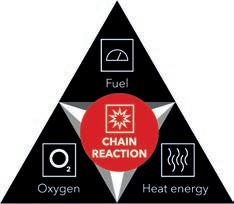
Non-combustible insulation on building services installations (such as ductwork/pipework) significantly reduces a building’s fire load
With reference to Regulation 7, investors choosing combustible insulation should appreciate that the cost of any offer of insurance may increase as insurers estimate potential losses.
E – Anticipate arson attempts
Arson is the criminal act of deliberately setting fire to property. It is the most common cause of fire in the UK, accounting for 50.5% of all fires attended by the fire and rescue service. Arson caused an estimated economic loss between £5.37bn and £11.46bn over 2017/2018, according to insurer Zurich. Risk of arson can be mitigated with non-combustible insulation, resisting the spread of fire beyond cosmetic damage to paint and render.
F – Monitor building services
Building services include heating, lighting and power (including renewable energy). Non-combustible insulation on building services installations
(such as ductwork/pipework) significantly reduces the fire load within a building.
H – Extend structural stability
It is in everyone’s best interest for a building to remain structurally sound long enough for people to escape.
When steel is exposed to high temperatures it softens and loses strength, affecting the loadbearing capacity of a steel building. Insulating structural steel from the high temperatures experienced in a fire slows the rate at which heat is absorbed, mitigating the risk of building collapse.
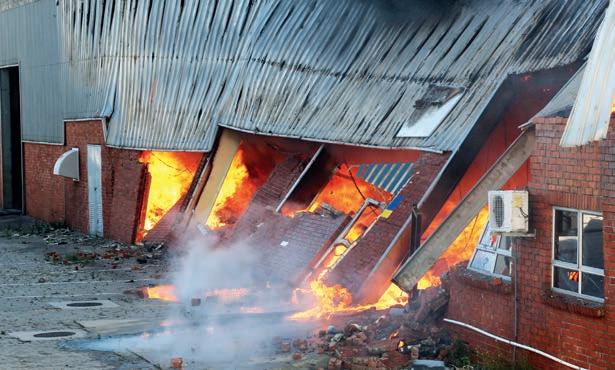
I – Reduce fire severity
Compartmentation is a vital part of the fire safety design of a building and seeks to divide large areas into smaller and more manageable ones should a fire occur. This prevents the spread of fire, smoke and toxic gases, and provides time to allow for adequate means of escape.
The key aim when compartmenting a building is to stop fire spread around and through compartment elements. Firestopping reinstates the fire rating of compartment elements through effective measures where service penetrations occur.
J – Control compartment cavities
Where reasonably practicable, cavities within internal compartments should be designed out. Firestopping products, including intumescent materials, should be installed to prevent unseen routes for the passage of flames, heat and smoke, and demonstrate through appropriate certification the ability to provide fire resistance and insulation equal to the relevant compartment line.
As per Principle J.2 of the Essential Principles, intumescent materials must not be used if they fail to activate immediately to prevent the passage of flame, heat and hot or cold smoke.
40 | CONSTRUCTION MANAGEMENT JULY/AUGUST 2023 n CPD constructionmanagement.co.uk
High temperatures affect the loadbearing capacity of steel
Case study: St Alban’s Primary School
Arsonists gained access to a flat roof at St Alban’s Primary School in Wednesfield, Wolverhampton. The blaze spread across the whole roof, requiring dozens of firefighters to control it.

The school remained closed for weeks, causing 177 pupils to be relocated. “It has not only disrupted education and learning for more than 100 of our young people, but has also caused a great deal of distress to pupils, parents, and teachers,” said councillor Phil Page.
L – Resist fire ingress
Statutory Instrument 2010 No 2214: Schedule states: “The external walls of the building shall adequately resist the spread of fire over the walls and from one building to another, having regard to the height, use and position of the building.”
Approved Document B (ADB) of the Building Regulations, specifically regarding resisting fire spread over external walls, states buildings over 18m require all external wall materials to be A2-s1,d0 or A1 rated (exceptions for gaskets, membranes etc).
It is important that non-combustible materials are used wherever possible, going
above and beyond minimum requirements to futureproof the fire safety of buildings.

N – Minimise consequential damage
Building fires have environmental and ecological impacts that affect building surroundings. Short-term fire effects mainly impact the local environment within the fire plume zone –namely air contamination. Water courses are also affected by the water runoff, which can contain extinguishing agents.
Long-term effects are more likely to impact the water supply and contaminate soil in the area of the fire. Airborne fallout of fire (ash, chemicals etc) deposits into the ground, contaminating the soil and water courses. Water should be treated before entering and disrupting nearby water supplies.
T – Procure quality materials
Before any fire protection material, product or system can be placed on the market it must undergo fire testing appropriate to its design. Generally, there are three tiers of evidence used to support products in the market:
It is vital that protection measures are installed by identified specialists trained and supervised under thirdparty quality of work schemes accredited by UKAS
l First-party certification
An individual or organisation provides goods or services with an offer of assurance that they meet certain claims.
l Second-party certification
An association to which the individual or organisation belongs to provides some assurance by virtue of membership.
l Third-party certification
An independent verification and assessment undertaken by a certification body which is accredited by the UK Accreditation Service (UKAS) to confirm the
product, person, process or management system meets the requirements as stated. It is regularly audited to ensure no changes have occurred that would affect performance or process. Third-party approval provides peace of mind to designers or specifiers with systems going through approval processes to be deemed suitable or fit for purpose. It is often necessary to support the use of products with third-party approvals, thus reducing risk when applying products to a specific application.
U – Require competent work
It is vital that protection measures are installed by identified specialists trained and supervised under third-party quality of work schemes accredited by UKAS, with full disclosure of fire safety information.
Independent third-party certification and accreditation sets a standard for installers and regularly assesses their credentials. There are various independent schemes available, and a building control body may accept certification under a scheme of its choice. However, it should be established before the start of building work that a scheme is adequate for the purposes of the Building Regulations.
CONSTRUCTION MANAGEMENT JULY/AUGUST 2023 | 41 CPD n constructionmanagement.co.uk
50.5
Percentage of fires caused by arson in the UK
Fire wall (FW) compartmentation
V – Verify recorded information
It is essential to only accept pertinent and accurate information at handover and insist contractors satisfy statutory and contractual duties. Regulation 38 puts a statutory requirement on persons carrying out work to provide fire safety information to the responsible person no later than the date of completion or the date of occupation of the building (whichever is earlier). The aim of this is to ensure the responsible person has sufficient information relating to fire safety to enable them to:
l Understand and implement the fire safety strategy of the building;
l Maintain any fire safety system provided in the building; and
l Carry out an effective fire risk assessment of the building.

Y – Keep maintenance commitments
Specialist operatives are responsible for active, passive and procedural fire risk assessments. Risk assessments should be carried out
at the start of a building/business occupancy and then at regular intervals, typically annually.
There are four types of assessments that can be carried out on blocks of flats:
l Common parts only (nondestructive): basic risk assessment: entrance doors, access points etc.
l Common parts only (destructive): similar to non-destructive but will include opening up areas for inspection, eg integrity of compartment walls.
l Common parts and flats (non-destructive): as common parts only but it includes inspection of a number of sample flats assessing such as means of warning and escape, fire resistance to doors, suspected fire risks etc.
l Common parts and flats (destructive): similar to non-destructive but includes destructive inspection in common areas and flats.
Inspections should be extensive and ensure systems are working correctly, building users are aware of fire procedures, changes to building use or layout don’t compromise safety and future repairs lie with the responsible person in line with Regulation 38.
The pragmatic approach
The goal of BDM01 is to re-evaluate how designers view legislation – not as a benchmark, but as the bare minimum designed to be exceeded.
To conclude, some key points to take away from the Essential Principles:
l Consider the building as a system.
l Make the whole envelope non-combustible, not just the facade.
l High-rise, high-risk buildings.
l Always consider third-party approved contractors.
l Specify products with third-party certification to ensure the product installed is the product tested.
l Non-combustible insulation can support in reducing the fire load.
l Compliance with insurance industry guidance may help premiums, will help manage risk and potentially save costs and perhaps lives. l
CPD Questions
1) Which of these is not an element of the fire triangle?
a) Metal b) Fuel c) Heat d) Oxygen
2) Which of these statements is true?
a) Cavities help stop the spread of fire
b) Compartmentation should have a minimum fire classification of A2
c) Compartmentation subdivides bigger areas into smaller areas
d) Compartmentation stops the spread of fire and smoke, but not toxic gases
3) Which of the following provides an independent verification undertaken by a UKAS-accredited body?
a) First-party certification
b) Second-party certification
c) Third-party certification
d) None of the above
4) Which of the following supports reducing the fire load?
a) Compartmentation
b) G4 filters
c) An effective fire safety strategy
d) Non-combustible insulation
5) Which document puts a statutory requirement on persons carrying out work to provide fire safety information?
a) Approved Document L
b) Regulation 38
c) BDM01
d) Statutory Instrument 2010
No 2214
To test yourself on the questions above, go to www.construction management.co.uk/cpd-modules
42 | CONSTRUCTION MANAGEMENT JULY/AUGUST 2023 n CPD constructionmanagement.co.uk
The goal of BDM01 is to re-evaluate how designers view legislation – not as a benchmark, but as the bare minimum designed to be exceeded
 Andy Dunbar Decipher
Andy Dunbar Decipher
delayed due to archaeological finds’
project
This month’s contract clinic question comes from a contractor who found some historically significant artefacts when excavating a site – and is now worried about the ensuing delays during archaeological investigations. Andy Dunbar examines the contractual implications

THE QUESTION
Work on our new development has recently begun. In the process of excavating the site, we came across some historical artefacts we were unaware of, under the ground. Archaeologists have now confirmed that these are of historical significance, and they will need access to the site for a number of months. Our project now runs the risk of significant delays. What can we do to mitigate this and who is responsible for the associated costs?
THE ANSWER
Archaeological discoveries can be exciting events and aren’t too uncommon on today’s construction sites. However, when these discoveries do happen they can cause serious delays. It’s important to have a plan to resolve any potential project delays and a plan to mitigate the time lost.
So, what steps can a contractor take to mitigate these types of delays? And who might be responsible for the extension of time?
Steps to mitigate delays
The first step, after the contractor has notified the employer, is for an archaeologist to evaluate the find. This will determine how significant the historical find is and the extent of the excavation required for a proper study. By hiring an archaeologist, the find is more likely to be correctly preserved. It sounds like this has happened already, which is positive.
There is a chance you may need to inform the relevant authorities, such as local councils. Depending on the nature of the find, you may need permits for excavation, which can be a lengthy process. The time required to apply for and obtain these permits requires consideration in any mitigation plans produced by the contractor.
Once the facts have been established, then you will need to create a plan to deal with the find. Engage with your supply chain and agree to the plan before notifying the employer of your intentions. You should consider the contract and ensure all notice obligations
have been fulfilled. The contractor should, after determining if the hold-ups are likely to delay the project, check if the find will entitle you to an extension of time. You should also consider adding some contingency, or schedule risk allowance, to allow for any unknowns.
Archaeological excavations can often lead to further discoveries, and there is an increased risk of further unknowns. It is essential that you closely follow your plan and monitor performance against it. Ensure you execute your plan carefully to mitigate any delays.
It is important to maintain a dialogue with the archaeologist throughout the project to ensure construction activities which have not been affected by the find can continue smoothly. You should also maintain robust and accurate contemporaneous records daily, to document the find and progress. This will make an extension of time application easier to process, should one be required.
44 | CONSTRUCTION MANAGEMENT JULY/AUGUST 2023 n Legal constructionmanagement.co.uk
‘Our
is
Depending on the nature of the find, you may need permits for excavation, which can be a lengthy process
You should maintain robust and accurate records daily, to document the find and progress. This will make an extension of time application easier to process if needed
You may also want to consider making the public aware of the historical discovery and the preservation efforts being made, in which case a communications strategy will be helpful.
Who is responsible for the extension of time?
An extension of time is dependent on the contract between the parties. The contract outlines the responsibilities of both parties if an unforeseen delay has occurred, and some have standard clauses for dealing with archaeological discoveries.

JCT has ‘Antiquities’ clauses. Under JCT, the contractor must notify the employer of this relevant event under clause 2.26.
In the NEC form, it will be a compensation event under clause 60.1. If the delay is caused by the late issue of permits from the local authority, then the extension of time might be shared between both parties. In all circumstances, the contract should be consulted to establish which party bears the risk.
Where circumstances like this occur, it is always best practice to review your contract, issue the relevant notice and manage the impact of the event between the relevant parties. ●
Andy Dunbar is senior consultant at Decipher.
CONSTRUCTION MANAGEMENT JULY/AUGUST 2023 | 45 Legal n constructionmanagement.co.uk
@
Question for contract clinic? Email construction-management@atompublishing.co.uk
What made you go into construction?
I have always been at ease working on construction sites. After assisting my father who is a retired carpenter, it seemed a natural progression to start my ‘official’ journey in construction in the 1980s as an apprentice carpenter at the age of 16. I always wanted to develop but didn’t anticipate some of the directions my career has taken.
Is there a specific project or achievement you are most proud of?
As a site manager and construction director, I have gained industry recognition, winning many national awards for my safety, quality, site and project management skills. I have also been a finalist for the Construction Manager of the Year Awards (CMYA) on two separate occasions. All of these awards I have accepted on behalf of the teams that I have been privileged to manage; the third-party recognition has been a culmination of everyone’s hard work.
2015 was a highlight for me. I won four awards from a warranty provider: UK’s Best Apartment; Best Home (over £3m) and Project Manager of The Year. Plus my employer received Best Company accolade. That year I was also nominated and finalist for CMYA.

46 | CONSTRUCTION MANAGEMENT JULY/AUGUST 2023 n Careers constructionmanagement.co.uk
Nick Cuffe FCIOB, operations director, ICW Technical Services, tells CM about awards, experience and the industry’s responsibility to sell itself
‘Treat people how you want to be treated, with respect and humility’
During my earlier work as a warranty professional, both as building surveyor and technical manager, I wrote a series of feature articles promoting good building practice and exposing areas of poor workmanship. I was also the creator of a technical manual for one of Britain’s largest warranty providers for new homes.
I hope to emulate this achievement for ICW with the update of its technical manual and creation of ‘key measures’, along with the development of an accompanying phone app.
How do you think becoming a fellow has helped you in your career?
The construction industry has given me an interesting living and I wanted to give something back. I first gained chartership in 1998 and then gained my fellowship in 2003. In 2021, I became a fellow of the Chartered Association of Building Engineers. I was also chair of the CIOB Dorset Centre on three separate occasions during 2005-16.
I continue to support the construction industry with my work within the institute as a committee member of the local area through the CIOB Hub for Wessex and Channel Islands and, more recently, support for the Belfast Hub. Working with the CIOB and eventually gaining fellowship has increased my confidence.
● Operations director, ICW (International Construction Warranties)‚
2021 to date
● Construction manager, Acheson Construction, 2019-21
● Colmar Construction (Poole): Managing director, 2016-19 Contracts manager, 2012-16
● Construction director, MPR Projects, 2009-12
● Contracts director, Wilding Butler, 2006-09
● Contracts manager, Acheson Construction, 2004–06
● Zurich Insurance: Building guarantee technical manager, 2001-04
Site surveyor, 1996-2001
What’s the most valuable training you’ve received and why?
The CIOB is an excellent advocate of good practice and leads the way for industry to follow and further develop our industry.
With my introduction of ICW to the CIOB, there is a greater understanding and recognition of the good work the institute does, and we are pleased to be associated with the CIOB through being a chartered building consultancy (CBC) and training partner. This relationship has also enabled ICW to gain greater recognition in the industry for its warranty and insurance products.
As I continue my career, returning to warranty work with one of the largest warranty providers in the UK – some say ‘poacher turned gamekeeper’ – I greatly enjoy working with the teams I support and manage across the UK. I have quite a varied portfolio of responsibilities as operations director, including health and safety of our onsite surveyors, survey administration and technical underwriting, all part of the Technical Services team providing support for the wider ICW Group.
What advice would you give to someone starting in construction today?
Public perception of the construction industry continues to be low. However, as an industry we also undersell ourselves. Our industry is not just about trades personnel
As an industry we undersell ourselves. Our industry is not just about trades personnel alighting on a site and assembling components to produce a building
Nick Cuffe FCIOB, ICW Technical Services
alighting on a site and assembling components to produce a building. Although this is part of the process, there are more stages involved in the completed product – among others: land acquisition, finance, design, warranty, planning, procurement, health and safety and project management.
All these disciplines are recognised by the CIOB. However, it is also the responsibilities of industry leaders to explain how these processes function and what variety and opportunities there are for those seeking a new career.
Do you have a motto that applies to your work and, if so, what is it?
I have been made to feel very welcome by the industry and now the team at ICW. I continue to look forward to supporting the company and individuals in reaching their goals and aspirations. This I have done throughout my lifetime and career in construction. If asked do I have a motto, the closest is that I treat people how I would want to be treated myself, with respect and humility. ●
CONSTRUCTION MANAGEMENT JULY/AUGUST 2023 | 47 Careers n constructionmanagement.co.uk Hundreds of the best jobs in construction. Recruitment news and insight. www.constructionmanagementjobs.co.uk CONSTRUCTION MANAGEMENT Brought to you by JOBS
Nick Cuffe CV
CIOB Community
CIOB scoops award for its work as EPAO
Awarding body recognises the institute’s role as an end-point assessment organisation
Change of guard at Maidstone for Tomorrow’s Leaders
Outgoing TL representative James Sergeant talks about his rewarding role

James Sergeant MCIOB is stepping down from his role as a Tomorrow’s Leaders representative (TLR) for Maidstone Hub after two years in the position.
Sergeant, part of Quigg Golden’s expert contracting team, specialising in the NEC3/4 and JCT, has been involved with CIOB since 2017, when he became a Novus Committee member. He will be handing over to two construction professionals: Joanna Johnson and Lindsey Platt.
CIOB recently won an award for its work as an end-point assessment organisation (EPAO). The assessment process makes sure each apprentice has gained the right knowledge, skills and behaviour to succeed.

The award – Specialist Sector Based EPAO of the Year – was announced at the EPA conference, awards and exhibition held at Warwick Conferences on 18 May. It was organised by the Federation of Awarding Bodies (FAB) – the collective voice of the awarding and assessment industry.
The EPA Awards recognises the contributions made by end point assessment organisations to apprentices, employers and to education and skills in England
over the past year. All winners are put forward for consideration to a separate independent judging panel, to decide the winner of EPAO of the Year 2023.
Tom Bewick, FAB chief executive, was delighted to receive so many entries to the inaugural awards.
“All the entries were of a really high standard and demonstrate the commitment of our EPAO members to high-quality assessment practices for apprentices, employers and the wider FE sector,” he said.
“There was tough competition for the winners of each of the four EPAO categories – and our thanks to our esteemed judges who had the very difficult job of selecting our four winners.” ●
The entries show the commitment of our members to high-quality assessment practices for apprentices, employers and the wider FE sector
Tom Bewick, FAB
Sergeant says his time in the role has been rewarding. “During this (relatively) early stage of my career, the Tomorrow’s Leaders Community has been invaluable to me. It has helped me to make connections within the Maidstone Hub via networking events, improve my knowledge of the as-built environment via CPDs – and I even got to attend Members’ Forum in Sydney!
“However, and more importantly, Tomorrow’s Leaders has also provided me with a platform to give back to the industry, by enabling me to attend schools and colleges to talk to students who, like me, might not otherwise have considered construction as a possible career.
“So, if you are new(ish) to the industry, and looking for a way to kickstart your career, while simultaneously giving back to the industry, I recommend that you contact your hub’s member services and events co-ordinator or your TLR, to discuss ways in which you can get more involved with the Tomorrow’s Leaders community. I promise, you won’t regret it.”
48 | CONSTRUCTION MANAGEMENT JULY/AUGUST 2023 n CIOB Community constructionmanagement.co.uk
Heron Bros expands its portfolio with major contracts across UK
CBC enjoys purple patch of project wins
Chartered building consultancy (CBC) Heron Bros has recently won multiple new contracts to add to its diverse portfolio.
The construction, property development and manufacturing company has secured the £70m Ballycastle Shared Education Campus in County Antrim, Northern Ireland. This involves creating a state-of-the-art educational building for Cross and Passion College and Ballycastle High School with extensive sports facilities.

The firm has also picked up the £13m Eurostampa UK project, which will expand and refurbish the labelprinting firm’s existing building in Cumbernauld to create a modern, specialised printing facility.
Heron Bros will shortly start on the £7m Clyde Gateway East project in Glasgow, to design and construct three single-storey portal frame industrial units with office space for Clyde Gateway Developments. Additionally, it won a £6.5m office fit out at Buchanan Wharf, Glasgow, for the Student Loans Company. Finally, the contractor has started on site with the £5m refurbishment of Knightsridge Primary School in West Lothian, and will soon start the £3m refurbishment of Balbardie and Windyknowe primary schools in Bathgate to remove reinforced autoclaved aerated concrete (RAAC) panels and replace the roof on both schools on behalf of West Lothian Council. ●
Heron Bros will shortly start on the £7m Clyde Gateway East project in Glasgow
Sixteen new Tomorrow’s Leaders join CIOB team


New champions take on inspirational role
Following a successful recruitment campaign, the Midlands & Eastern team is delighted to welcome 16 new Tomorrow’s Leaders champions to the region.
Heron Bros has won the £70m Ballycastle Shared Education Campus in County Antrim
Adegoke Akande, Titus Akpan, Pooja Ivvala, Mohammad Mahdi Pourhasani, Daniel Ojo, Oluwatomisin Olaoye, Francis Ndukwe, Jessica Reid, Feyisayo Ajayi, Samuel Adewole, Dean Allen, Ayorinder Ojo, Alex Playle, George Collins, Jamie Hazell and Kevin Page will all be stepping into the role.
Aimed at those in the early stages of their construction career Tomorrow’s Leaders (TL) is a global community, with self-development an integral part, designed to support CIOB members who would like to tap into their leadership potential.
TL champions across the globe are already leading the way, delivering activity aimed at the TL audience and playing a vital role in inspiring the next generation, while at the same time progressing in their own personal and professional development.
The new champions have said they are excited to be working alongside the hub committees and to achieving 2023 targets. For more information about becoming a Tomorrow’s Leaders champion please get in touch at midsandeastern@ciob.org.uk.
CONSTRUCTION MANAGEMENT JULY/AUGUST 2023 | 49 CIOB Community n constructionmanagement.co.uk
Feyisayo Ajayi and Pooja Ivvala
The site consists of two highly decorated 15th century timber-framed guildhalls and chapel, as well as further ranges of medieval buildings around a courtyard
The site tour, by specialist heritage contractor Messenger BCR, provided information on the works to transform it into a modern visitor attraction and illustrated the traditional craftsmanship used. In Kenilworth, Morgan Sindall offered insight into the construction of a new-build secondary school and sixth form on existing farmland. The new site will provide for 2,200 pupils with extensive sports facilities. ●
Old and new projects contrast on site visits
Northampton Hub members take in heritage and modern in Warwick and Kenilworth

CIOB’s Northampton Hub held two site visits recently, one to the historic Lord Leycester Hospital in Warwick and another to the brand-new Kenilworth School and Sixth Form.

The Grade I-listed Lord Leycester Hospital is an outstanding, internationally important collection
of buildings, constructed between the 13th and the 17th centuries, providing a home for Warwick’s medieval guilds.
The site consists of two highly decorated 15th century timberframed guildhalls and chapel, as well as further ranges of medieval buildings around a courtyard.
Successful CIOB annual dinner in Belfast
Attendees dine out to raise over £2,000 for CIOB Assist
Over 190 people attended the CIOB annual dinner at the Hilton Hotel, Belfast, in May. The master of ceremonies was John Campbell, BBC Northern Ireland economics and business editor. Speakers were Roger Gillespie, chair of the CIOB Northern Ireland Hub committee, as well as Caroline
Gumble, CEO of the CIOB. Popular TV personality Paddy Raff provided the postdinner entertainment. Sponsors of the event were Hays, Off the Wall Creative, Tughans, Training LMS, Quigg Golden and Keystone Lintels. Guests donated over £2,000 for CIOB Assist.

50 | CONSTRUCTION MANAGEMENT JULY/AUGUST 2023 n CIOB Community constructionmanagement.co.uk
The Grade I-listed Lord Leycester Hospital in Warwick Morgan Sindall’s Kenilworth School and Sixth Form site
Paddy Raff entertained the guests
Young gun takes on hub role with ambition to inspire
New vice chair Jack Bennion wants to encourage young people and promote CIOB
The CIOB Merseyside & Cheshire Hub committee has recently appointed a new vice chair, Jack Bennion. At 26 years old, he is one of the youngest vice chairs CIOB has had on a hub committee.

Despite his youth, Bennion has previously been heavily involved in CIOB activity. He joined in 2015 as a student member at university and in 2018 joined Novus, becoming vice chair and chair for Novus Liverpool.

He gained his MCIOB in 2021 and a year later became an assessor for other candidates to complete their chartership. A former CM ‘One to watch’ (see March 2022 issue), he was also a finalist for the Rising Star Award in 2022. He works as an architectural designer for Redrow Homes.
Talking about his latest role, Bennion said: “I believe, as a young professional, I was appointed to bring new blood into the role and inspire young people to join CIOB. I hope to bring the ideas and enthusiasm I have brought to CIOB’s Tomorrow’s Leaders and bring that same energy into the main hub.
“This new role is a great opportunity for me as it would increase my status within the industry and CIOB. I can learn a great deal from our new chair, Colin Davies, and look forward to working with him closely.
“When I graduated from university, I was keen to gain my chartership with CIOB, because of the benefits and status you get from it. But I also feel that since joining CIOB I can give back to it, putting my energies into helping and inspiring other people.
He explained: “For example, in my workplace there are not many people who have chartership – which has always surprised me. Because of this I want to express to others the great opportunities CIOB has given me and put CIOB at the forefront of people’s minds.”
One to watch
Ollie Crofts MCIOB Senior quantity surveyor, Burmor Construction
Why did you choose construction as a career? What else might you have done? Construction wasn’t my chosen career – my goal had always been to join the Royal Marines – but with family in construction it opened doors for me. Having researched careers in construction I found that the skills of a quantity surveyor aligned with my strengths, and my journey started from there with Burmor Construction.
Your involvement with CIOB activities has been immense: Tomorrow’s Leaders rep for CIOB Cambridge, joining the CIOB Cambridge Committee and representing at the Members’ Forum for the second time. Why so involved with CIOB?
I feel that encouraging and mentoring younger professionals into the industry is extremely important, and starting in the role of CIOB Tomorrow’s Leaders representative for the Cambridge Hub has given me a platform to provide opportunities and knowledge to the future leaders of the construction industry.
My drive for personal and professional development led me to successfully achieving MCIOB status in 2022, and now I am proud to be a representative of the committee at a regional and global level.
CIOB has given me access to a network, experiences and people that I would otherwise not have been able to reach and has been an invaluable tool. I am extremely grateful for the opportunity.
What are your career ambitions? Having been taught by my parents to strive for more, my ambition is this: to leave the industry in a better place than I found it. If I can reflect on my input, and map a notable change, I have had a winning career.
What do you do in your spare time? Even in my spare time I like to keep my mind active: I listen to podcasts and am completing an MBA in Construction and Real Estate. Away from the industry, I train in Brazilian jiu-jitsu and spend a lot of time exploring the outdoors.
CONSTRUCTION MANAGEMENT JULY/AUGUST 2023 | 51 CIOB Community n constructionmanagement.co.uk
I hope to bring the ideas and enthusiasm I have brought to CIOB’s Tomorrow’s Leaders into the main hub Jack Bennion, CIOB
My ambition is to leave the industry in a better place than I found it Ollie Crofts, Burmor Construction
DAVE BAGNALL PHOTOGRAPHY
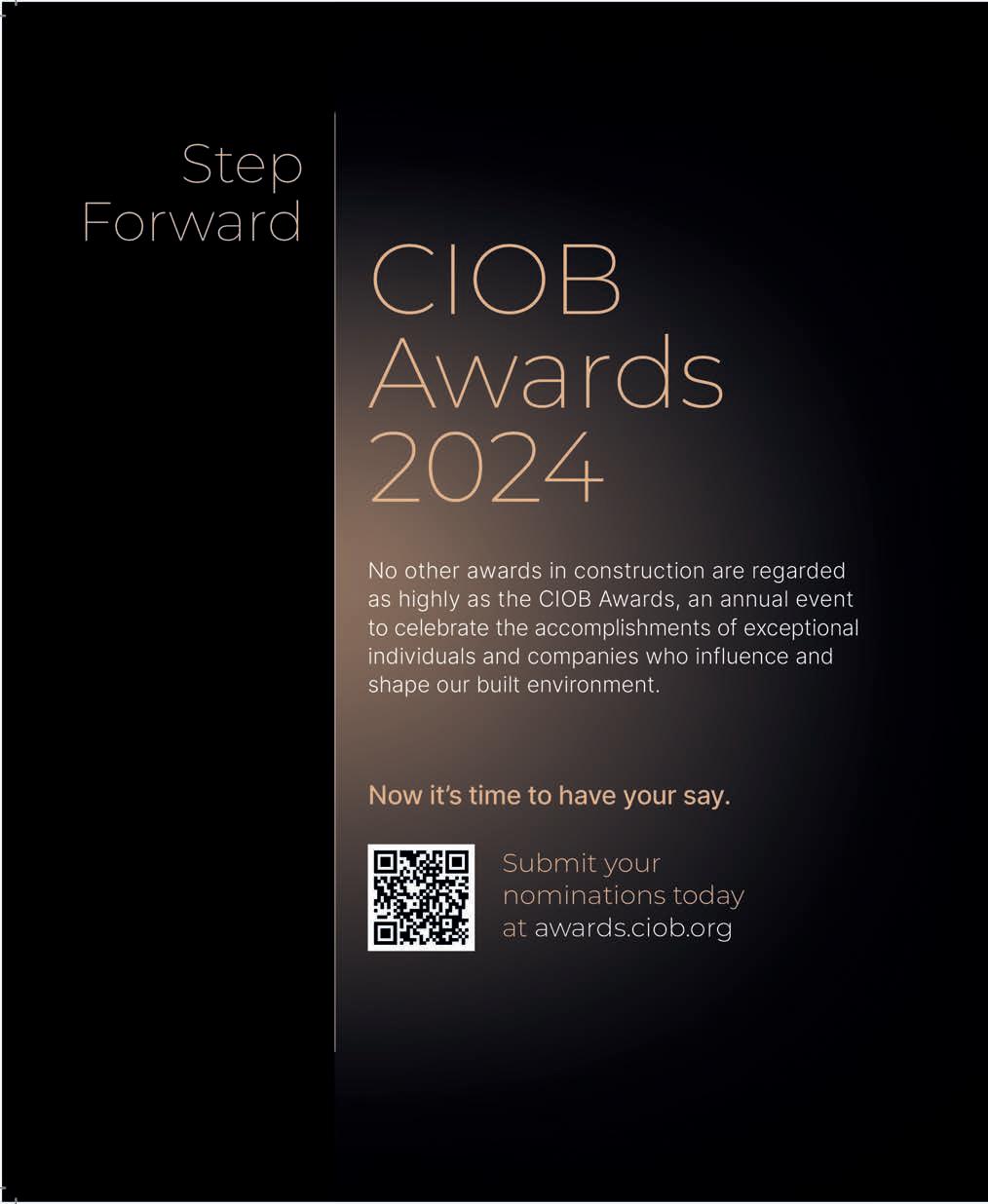
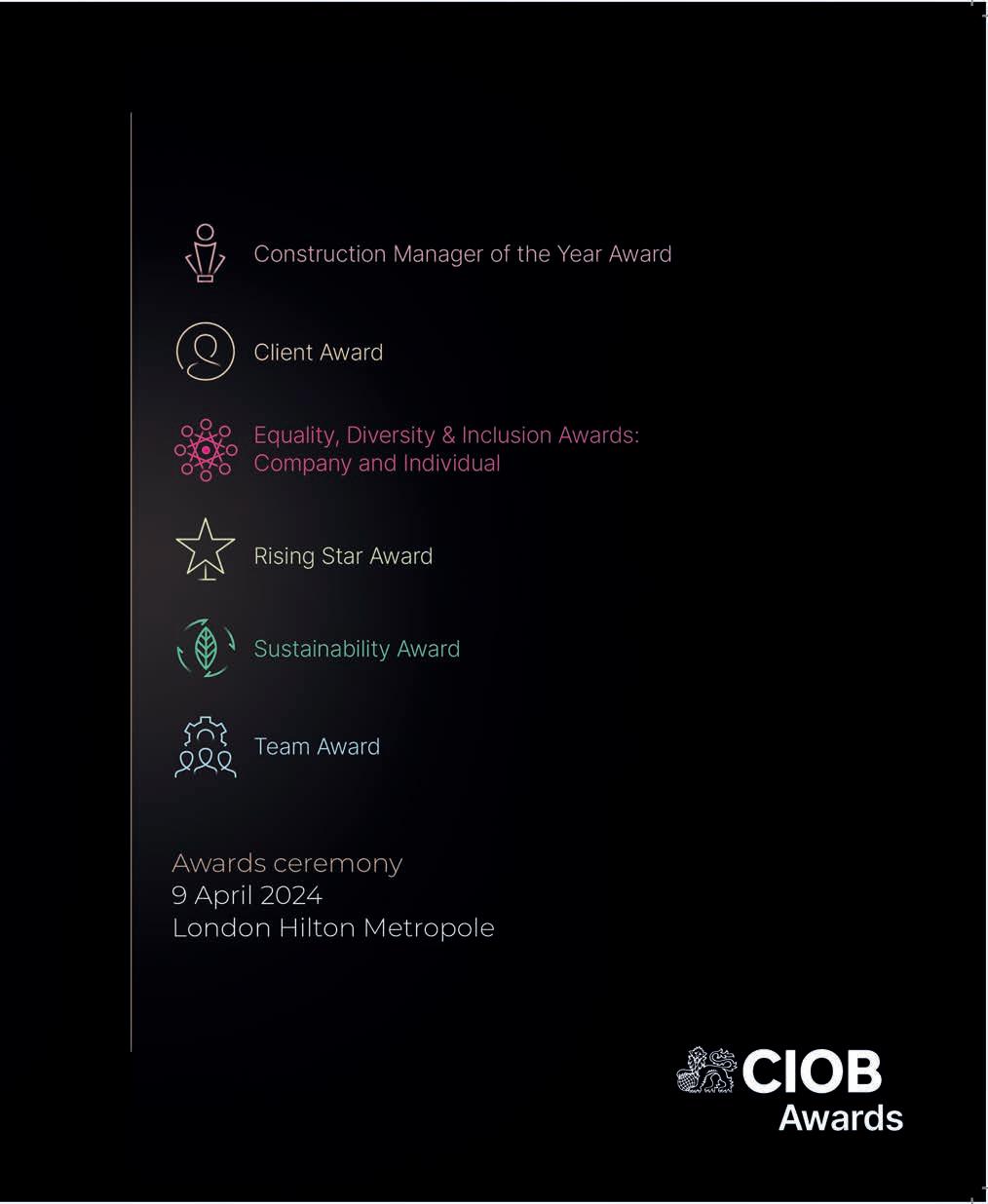
Apprenticeship levy unlocks business expansion for CBC
Bramwell Consultancy shares how it has benefited from the government funding
Fellow helps Hong Kong to plug knowledge gaps in design safety
A CIOB fellow and expert in building design has been working to facilitate the development of design for safety in Hong Kong.
Steve Coppin delivered Design for Safety masterclasses with the Construction Industry Council (CIC) in conjunction with its Reference Materials on the Design for Safety (DfS) Management System for the Hong Kong Construction Industry. Hong Kong construction work is forecast for the next eight years to rise from HK$225bn (£23bn)to HK$345bn (£35bn) a year but against a backdrop of recruitment and skills gap challenges.
Coppin explained: “This is to help all dutyholders realise the importance of integrating health and safety early in planning, procurement and design, to help establish they have the right team and identify and address any significant risks to help manage the construction
phase and the life cycle of the asset by ensuring who is doing what and when from the start.”
Coppin also met up with CIOB in Hong Kong: Steve Corry, CIOB associate director –international market development and Joseph Hol Leung Wong, CIOB development manager.

They shared industry challenges and discussed the right solutions for addressing the resources and skills gap – through further education, use of visualisation, forums/ workshops, universities and training centres for their students, and visits to live projects via engaging with the industry and employers.
Coppin also met CABE HK chair Kyran Sze to discuss how the manifesto and policy on collaborative working is being adopted by Hong Kong clients and developers or design or building engineering firms and consultancies.
Chartered building consultancy Bramwell Consulting is reaping the benefits of taking on an apprentice.
In 2022, founder and managing director Paul Bramwell began exploring the different options to appoint new employees to expand the company’s project controls and dispute resolution practice.

The consultancy decided to recruit an apprentice from a non-cognate route, with funding from the apprenticeship levy. The allowance provides employers with around 95% of the tuition fees costs towards their preferred course – which for Bramwell was an apprenticeship in digital and technology solutions.
“We took the plunge in summer 2022, and we are now well into the first year of our two-year apprenticeship programme with the University of Newcastle,” said Bramwell. “We meet with the university on a regular basis.”
He added: “We have found the balance between in-person lectures combined with personal study to be a successful blend of educational training. This is complemented by inhouse project-specific activities where we implement the skills gained on the course to develop the expansion of our business services.
“Our apprentice has assisted in the organic growth of our business and we have since added a further senior appointment. Without the
From top: Lewis and Paul Bramwell
UK government apprenticeship levy funding, we would have been more cautious, given the investment required from our practice.”
The arrangement is also working for the firm’s apprentice, Lewis Bramwell. He said: “The appointment with Bramwell Consulting has provided me with the opportunity to apply my mathematical and computational knowledge to implement new systems to the business.” ● To find out more about the apprenticeship levy, visit https://educationhub.blog. gov.uk/2023/03/10/how-areapprenticeships-funded-andwhat-is-the-apprenticeship-levy.

54 | CONSTRUCTION MANAGEMENT JULY/AUGUST 2023 n CIOB Community constructionmanagement.co.uk
Steve Coppin met up with CIOB representatives on recent visit
Steve Corry, Steve Coppin and Joseph Hol Leung Wong
Primary school pupils get inspired at Henry Brothers careers day
Hands-on session at Magherafelt HQ gives students a chance to try out a variety of construction techniques
OBITUARY: Michael Tastard DipArch, FRIAS, RIBA
27 January 1946 –
4 March 2023
Pupils at Woods Primary School in Magherafelt, Northern Ireland, recently got a taste for working life at a job sampling and careers day hosted by chartered building consultancy (CBC) Henry Brothers.
The enlightening hands-on session at Henry Group’s Magherafelt headquarters offered the pupils a chance to try a variety of roles, including bricklaying, plastering, tiling and joinery –as well as giving insights into both the industry and the history of the company.
Ian Henry, corporate responsibility director at Henry Brothers, commented: “This is the first time that we have hosted this event for primary school students, giving them experience of a real-life working environment and the chance to get stuck in with various activities found on a construction site.
“We hope that events such as these motivate them to pursue a career in construction.”
Karen White, principal at Woods Primary School, said: “Visits like
n NEWS IN BRIEF
New CBCs
Five companies secured chartered building company or consultancy status in the Midlands and Eastern area of CIOB in May. They are Hindley Contractors, Barrett Corp & Harrington, Omnium Projects, Stevenson Bros and Trec Developments.
A Woods pupil tries out bricklaying
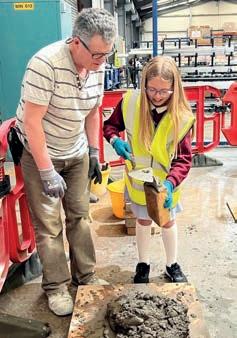
this are a great way to showcase the wide range of career options available to young people within the construction and engineering sectors. The pupils enjoyed having conversations with many different construction professionals and loved the hands-on experiences provided.” ●
Book now for Scotland Awards Bookings are still being taken for the CIOB in Scotland Awards Lunch, sponsored by Contract Scotland and Competence Matters.
Hosted by Nicky Marr and with guest speaker John McKelvie, the event will celebrate the successful
winners at DoubleTree by Hilton, Glasgow on 15 September. Nominations closed at the end of June and the finalists will be announced at the end of July. Please note that there is limited availability on Silver Packages. To book your space or for more details email wmarshall@ciob.org.uk.
Michael Ernest (Mike) Tastard, who was presented with the CIOB Open Award in 2011 for his contribution to the construction industry, has died.
Born in 1946, he was raised in Aberdeen and schooled at Robert Gordon’s College in the city. He studied architecture at the Scott Sutherland School in Aberdeen from 1965-71, graduating with distinction in building design and technology and receiving the Aberdeen Society of Architects Silver Medal and the Harbourne MacLennan Prize.
Tastard’s early career saw him work for the City of Coventry architects’ department on a number of prominent civic projects. For family reasons, he returned to Aberdeen in 1979 and took up a position with the city architects’ department. In 1980 he joined Mackie Ramsay Taylor Architects as a project architect and was quickly promoted, rising to senior partner in 1992.
During his time as senior partner, he was the driving force behind the practice, maintaining a strong public sector workload of hospitals, health centres and schools and a private sector portfolio of retail, commercial, residential and leisure sector projects.
Tastard had a strong interest in landscape design as well as building design and considered the two as inseparable. His work has been recognised by the Civic Trust, the Saltire Society, the Civic Society and SABA. In 2015 he was elected as a Fellow of the Royal Incorporation of Architects in Scotland.
He retired from Mackie Ramsay Taylor in 2010, but continued to challenge himself with the design and construction of a house in East Lothian. He is survived by his wife Hazel, two daughters and grandson.
CONSTRUCTION MANAGEMENT JULY/AUGUST 2023 | 55 CIOB Community n constructionmanagement.co.uk
We hope that events such as these motivate them to pursue a career in construction
Ian Henry, Henry Brothers
Hidden figures
Retrofitting and refurbishing is a way to reduce construction’s energy consumption, but can it work on large projects? Sir
Robert McAlpine

explains the hidden costs of carbon at the Westbury Hotel
Retrofitting and refurbishing the UK's building stock, instead of knocking down and rebuilding, is one of the key ways the UK's construction industry can significantly reduce its energy consumption and carbon footprint. The built environment is directly responsible for 25% of total greenhouse gas (GHG) emissions (UKGBC) and, while the industry appears to be promoting retention and retrofit to reduce emissions, it is crucial to acknowledge the consequences of larger refurbishments in terms of embodied carbon.
The Westbury Hotel in London involved horizontal and vertical extensions above and below a reinforced 1950s concrete frame to make it a ‘best in its class’ hotel in Mayfair. While its refurbishment saved over 2,000 tonnes of demolition waste and approximately 3,700 tonnes CO2e when compared to a demolition and new-build option for the same gross internal area, there were hidden carbon costs.
For example, jacking up an eight-storey reinforced concrete frame requires substantial temporary works. Each column needs unique steel jacking frames that transfer load from the existing column to temporary plunge column piles. Using mini piles in an existing building can also come with challenges, such as limited pile diameter and the use of fine aggregates and a higher cement content, which increases embodied carbon.
Refurbishments also typically require small tonnages of steelwork, and it is difficult to specify the mill or origin source of the steel, given the current procurement models of UK stockists. While reclaimed steel is preferred, it is sadly not yet standard practice.
Site investigations and fire analysis revealed the building’s existing reinforced concrete slabs and half of the reinforced concrete columns required additional fire protection to comply with fire regulations. These relatively carbon-intensive materials can add up.

While retention and retrofit are great ways to reduce the carbon footprint of new buildings, it is essential to remember that extensive refurbishments can come with hidden carbon costs. By working with existing buildings and not imposing new-build aspirations, we can reduce carbon and improve overall design quality. It’s key to be mindful of the small things that can quickly accumulate and increase the embodied carbon.
The Westbury Hotel is being delivered by Sir Robert McAlpine’s Special Projects division; Ramboll UK is structural engineer. Sir Robert McAlpine is committed to decarbonising its business and has developed ambitious emission reduction targets for its scope 1, 2 and 3 emissions aligned to a 1.5°C emissions pathway.
Sir Robert McAlpine has submitted these targets for validation by the Science Based Targets initiative (SBTi) against the Net-Zero Standard framework, currently the most ambitious designation available. The writers – Brogan MacDonald, head of sustainability in building structures at Ramboll, Tom King, carbon manager at Sir Robert McAlpine, and Pedro Flores, sustainability manager at Sir Robert McAlpine – presented at the CIOB Conservation Conference in April 2023, where Sir Robert McAlpine Special Projects was a Gold sponsor. ●
56 | CONSTRUCTION MANAGEMENT JULY/AUGUST 2023 n Partnership constructionmanagement.co.uk
In association with
375 300 225 150 75 0 kgCO 2 e/m2 n New build – composite metal deck and steel frame n New build – flat slab n Refurb and extension
On site at the Westbury Hotel, Mayfair Embodied carbon figures for the Westbury Hotel: demolition plus new-build options compared with refurbishment and extension (chosen method)

Diary dates
Highlights of the CIOB Calendar for the coming month
Site visit: Gorse Ride redevelopment project
4 July, 3.30-5.30pm, Finchampstead, Wokingham
Members can visit the regeneration of Gorse Ride – one of Wokingham council’s flagship housing projects. The build will see 249 new modern homes built on the site, 74% of which will be affordable homes. The phased regeneration will take place over a number of years.
Designed to be energy efficient, the new homes have high levels of insulation and low-carbon innovations such as air source heat pumps, and tackle fuel poverty by bringing down the costs of power. Contact: ecatalano@ciob.org.uk
Site visit: Ivy Lane redevelopment, Oxford
4 July, 5.30-7pm, Oxford
Housing provider A2Dominion and housebuilder Hill Group are delivering a scheme of 125 units to house a minimum of 340 key workers at the John Radcliffe Hospital in Oxford.
CONSTRUCTION MANAGEMENT
Due to complete in October 2025, the scheme includes seven new apartment buildings, from three to five storeys high, made up of 68 apartments and 57 cluster units. Shared units comprise four or five bedrooms and a kitchen.
The scheme also includes facilities such as management offices, a meeting area, bike and car parking, and landscaped communal green open space.
Contact: ecatalano@ciob.org.uk
CPD seminar: Understanding and Maximising Social Value
4 July, 7-9.30pm, Maidstone
The recent Policy Note to the Public Services (Social Value) Act (2012) ensures that social value will become a mainstream priority.
This CPD seminar, presented by Natalie Webster, senior social sustainability manager at Kier Construction, covers the following:
l legislation change: in 2020 it became a requirement to explicitly evaluate social value on government construction works rather than just consider it;
l measuring social value;
l useful tools/resources, such as social value calculators; and
l best practice: looking at recent changes and how change is pushing forward.
Contact: blawrence@ciob.org.uk
Switchboard: +44 (0)20 7490 5595
Editor: Will Mann will.mann@atompublishing.co.uk
Deputy editor: Cristina Lago cristina.lago@atompublishing.co.uk

Production editor: Sarah Cutforth
Art editor: Heather Rugeley
Community editor: Nicky Roger nicky@atompublishing.co.uk
Advertising manager: Dave Smith dave@atompublishing.co.uk

Key account manager: Tom Peardon tom@atompublishing.co.uk

Credit control: Eva Rugeley eva@atompublishing.co.uk
Managing director: Stephen Quirke stephen@atompublishing.co.uk
Site visit: MMC in action at Northminster residential project, Peterborough
5 July, 4.30-6pm, Peterborough
Join us for this presentation and tour to demonstrate the MMC and offsite techniques being used to deliver this significant mid-rise residential development in the heart of the city of Peterborough.
Contact: schalmers@ciob.org.uk
Building Brum & CIOB: A golden decade of Birmingham
6 July, 5.30-9pm, Birmingham
This discussion will be focused on the role of the environmental, social and governance (ESG) framework, in delivering high-quality buildings. Guests will hear how ESG has shaped masterplanning and regeneration, from Perry Barr to Paradise Birmingham. They will look ahead at the golden decade of Birmingham, focusing on what needs to happen to enhance and create healthy, strong communities
Chaired by CIOB president Sandi Rhys Jones, the panel is: Philip Nell, Birmingham City Council director of property and investment; Shauna Bradley, partner, Howells; Simon Raiye, development director, HBD; Lucille Watkins-Brazier, head of social value, Lendlease; and Tom Wraight, regional director, Careys. Contact: gfloyd@ciob.org.uk
Circulation: Net average 31,416
Audit period: July 2021 to June 2022
Subscriptions: To subscribe or for enquiries, please contact: Subscription team: Tel: 01293 312160 Or go online at: https://constructionmanagement. imbmsubscriptions.com
Or write to us at the address below:
Construction Management Published for the Chartered Institute of Building by Atom Media Partners, 26-27 Bedford Square, London United Kingdom. WC1B 3HP construction-management@ atompublishing.co.uk
Site visit: Envision AESC’s second UK gigafactory
7 July, 12-1pm, Sunderland
Join the North East Hub and Wates Group on the site of a new gigafactory in Sunderland. The project, the largest by single value in Wates’ 125-year history, is AESC’s second Sunderland battery plant.
The gigafactory, which will be powered by 100% net zero carbon energy, will have capacity of 12GWh and will employ more than 1,000 people when operational in 2025.
The visit will include a tour of the site facilities, a presentation from the team and overview with Q&A. Contact: dmoore@ciob.org.uk
Site visit: Transport Hub, Belfast Grand Central Station
31 August, 12-2pm, Belfast
The new Belfast Transport Hub is a key NI Executive flagship project. It will deliver a modern, world-class hub which, when complete in 2025, will be the largest integrated transport facility on the island of Ireland.
Main works are in progress and members will be shown the site by Duane A McCreadie, project director for Farrans-Sacyr JV. Contact: jfitzsimmons@ciob.org.uk
For a full list of events and to register visit www.ciob.org/events.
Construction Management is published monthly by Atom Media Partners. The contents of this magazine are copyright. Reproduction in part or in full is forbidden without permission of the editor. The opinions expressed by writers of signed articles (even with pseudonyms) and letters appearing in the magazine are those of their respective authors, and neither CIOB, Atom Media Partners nor Construction Management is responsible for these opinions or statements. The editor will give careful consideration to material submitted – articles, photographs, drawings and so on – but does not undertake responsibility for damage or their safe return. Printed by Precision Colour Printing. All rights in the magazine, including copyright, content and design, are owned by CIOB and/or Atom Media Partners. ISSN 2755 8649
58 | CONSTRUCTION MANAGEMENT JULY/AUGUST 2023 n CIOB Community constructionmanagement.co.uk
JULY/AUGUST 2023
#PPETHATFITS CAMPAIGN THE CITY’S FLOATING CRANE HEAD INJURIES IN CONSTRUCTION constructionmanagement.co.uk ‘LISTEN TO ALL THE VOICES’ NEW CIOB PRESIDENT SANDI RHYS JONES WANTS A MORE COLLABORATIVE INDUSTRY





















 Cristi Worm
Cristi Worm
















































































 Andy Dunbar Decipher
Andy Dunbar Decipher

























